TP Link Technologies C5SVI C5s FDD-LTE Smartphone User Manual
TP-Link Technologies Co., Ltd. C5s FDD-LTE Smartphone
Contents
- 1. user manual I
- 2. user manual II
user manual I

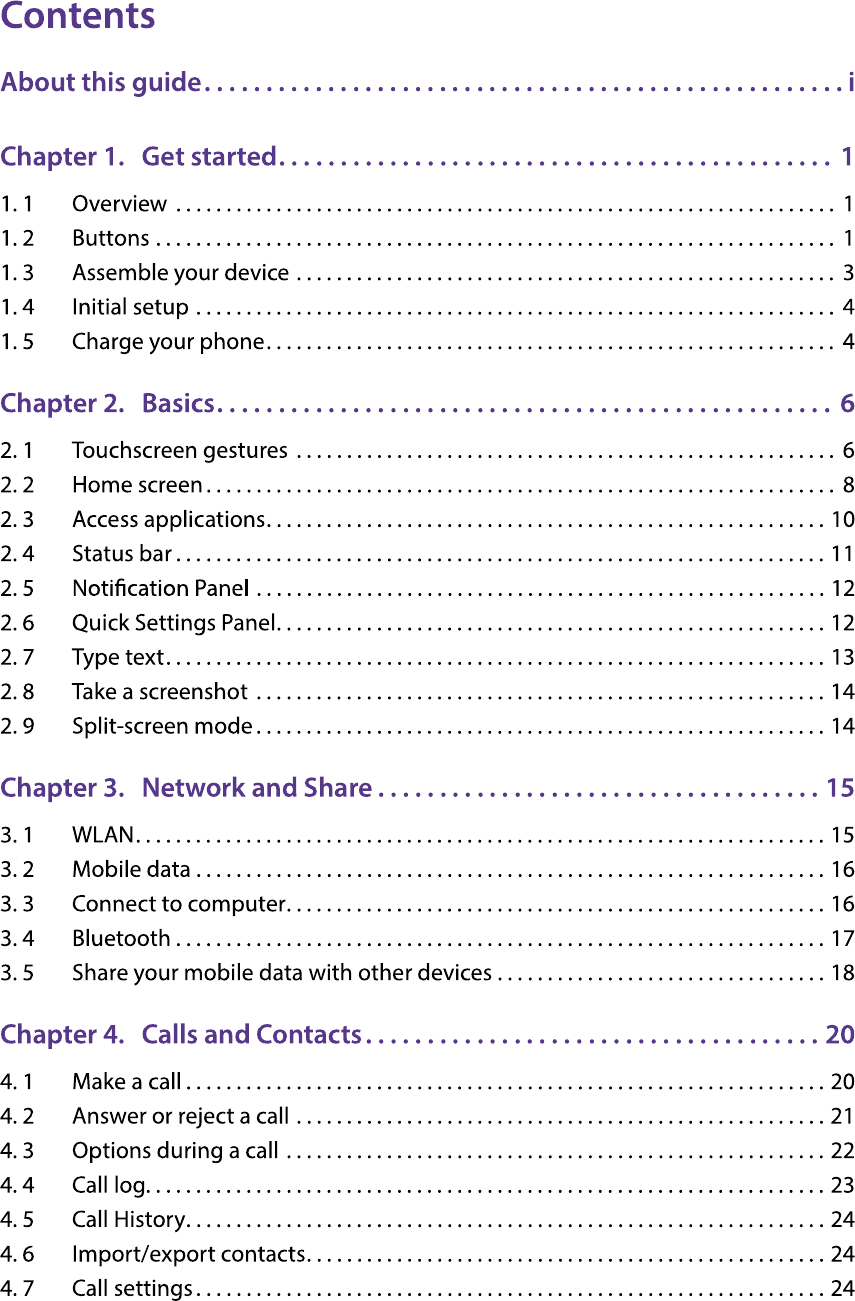
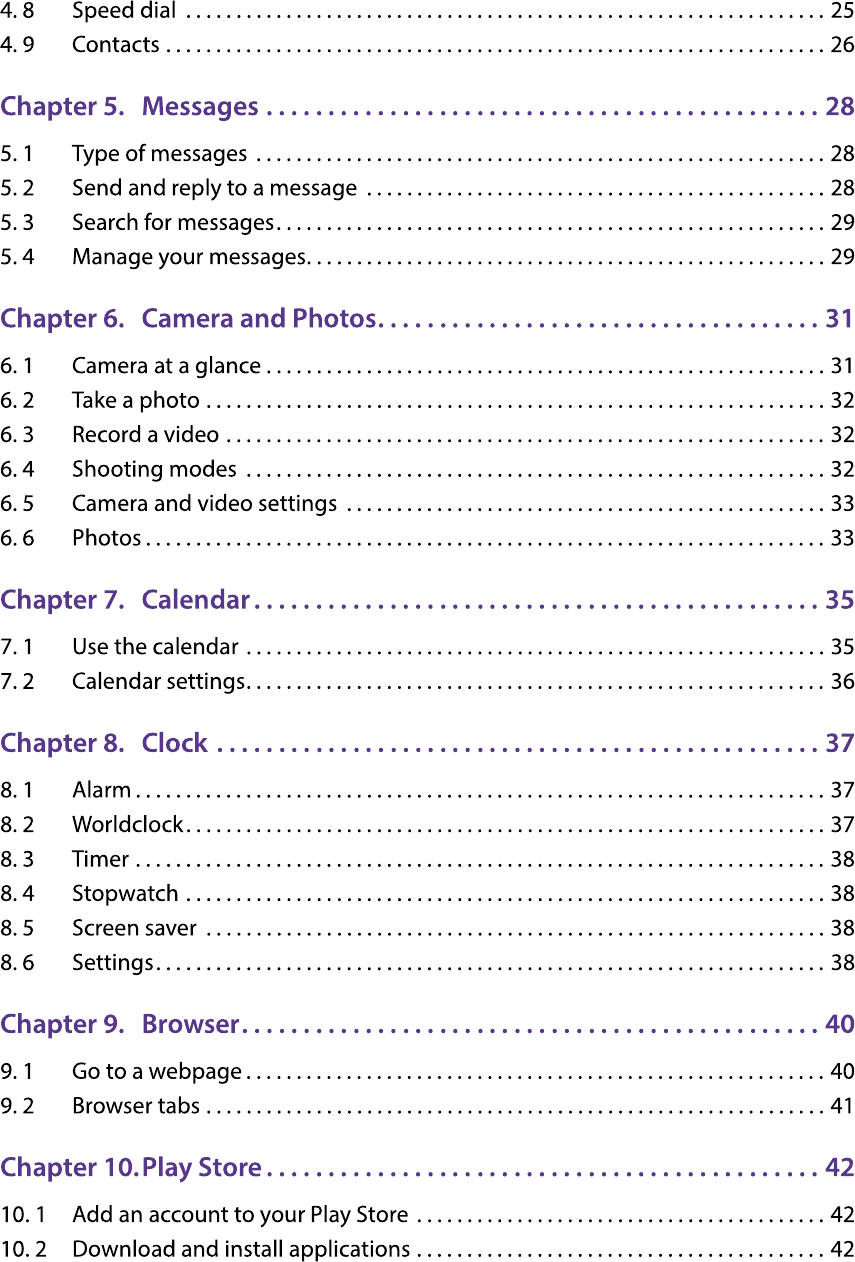
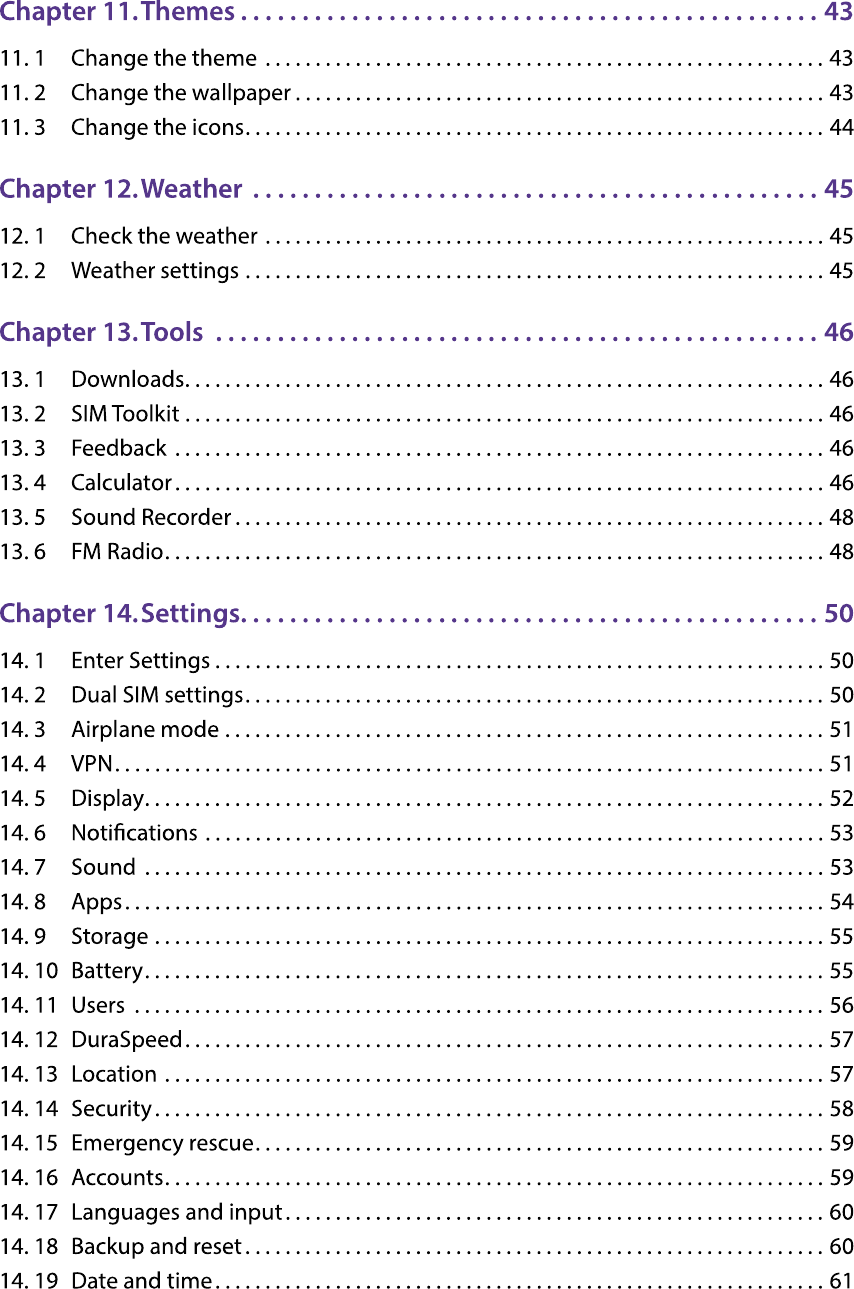
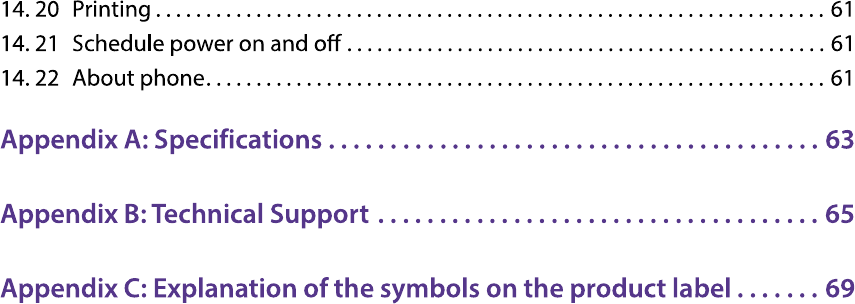
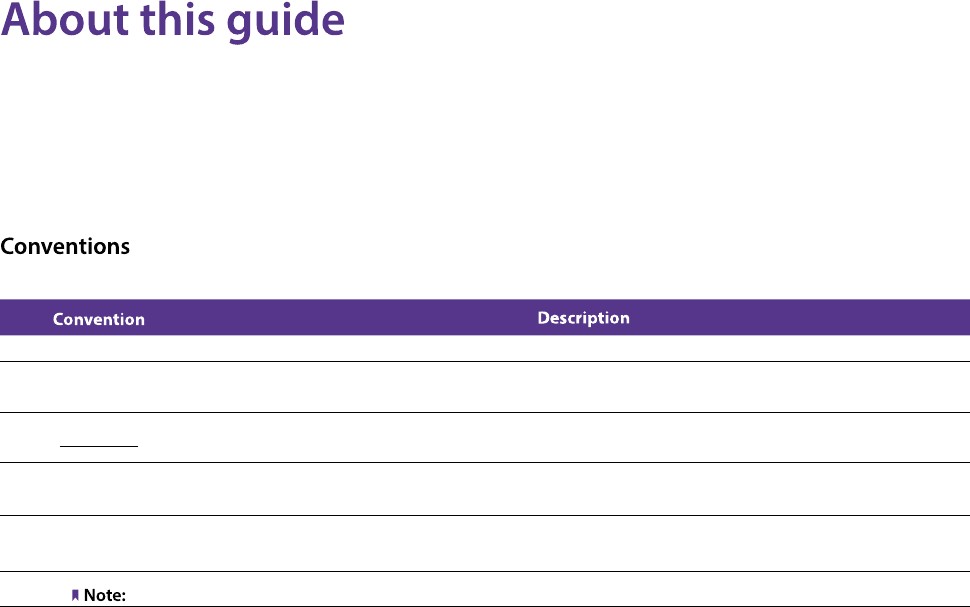
This guide is a complement to Quick Start Guide. The Quick Start Guide provides instructions for quick setup, while this guide
provides details of each function and shows how to configure the smart phone appropriate to your needs.
When using this guide, please notice that features of the device may vary slightly depending on the model and software
version you have, and on your location, language, and Internet service provider. All screenshots, images, parameters and
descriptions documented in this guide are used for demonstration only.
In this guide, the following conventions are used:
Smart phone/phone Stands for Neffos C5s without any explanation.
Parameters Parameters provided in the screenshots are just references for configuring the smart phone, which may be
different from the actual situation. You can set the parameters according to your demand.
Underlined Italic and underlined words or phrases are hyperlinks. You can click to redirect to a specific section for more
details.
Screenshots The demonstrated screenshots may look a little different from the actual UI of your smart phone due to the
various firmware versions. Please just configure your phone based on the actual UI.
-> The menu structure which shows the path to enter the corresponding page. For example, Settings -> WLAN
means the WLAN function page is under the Settings menu.
Ignoring the notes in the guide might result in a malfunction or damage to the device.
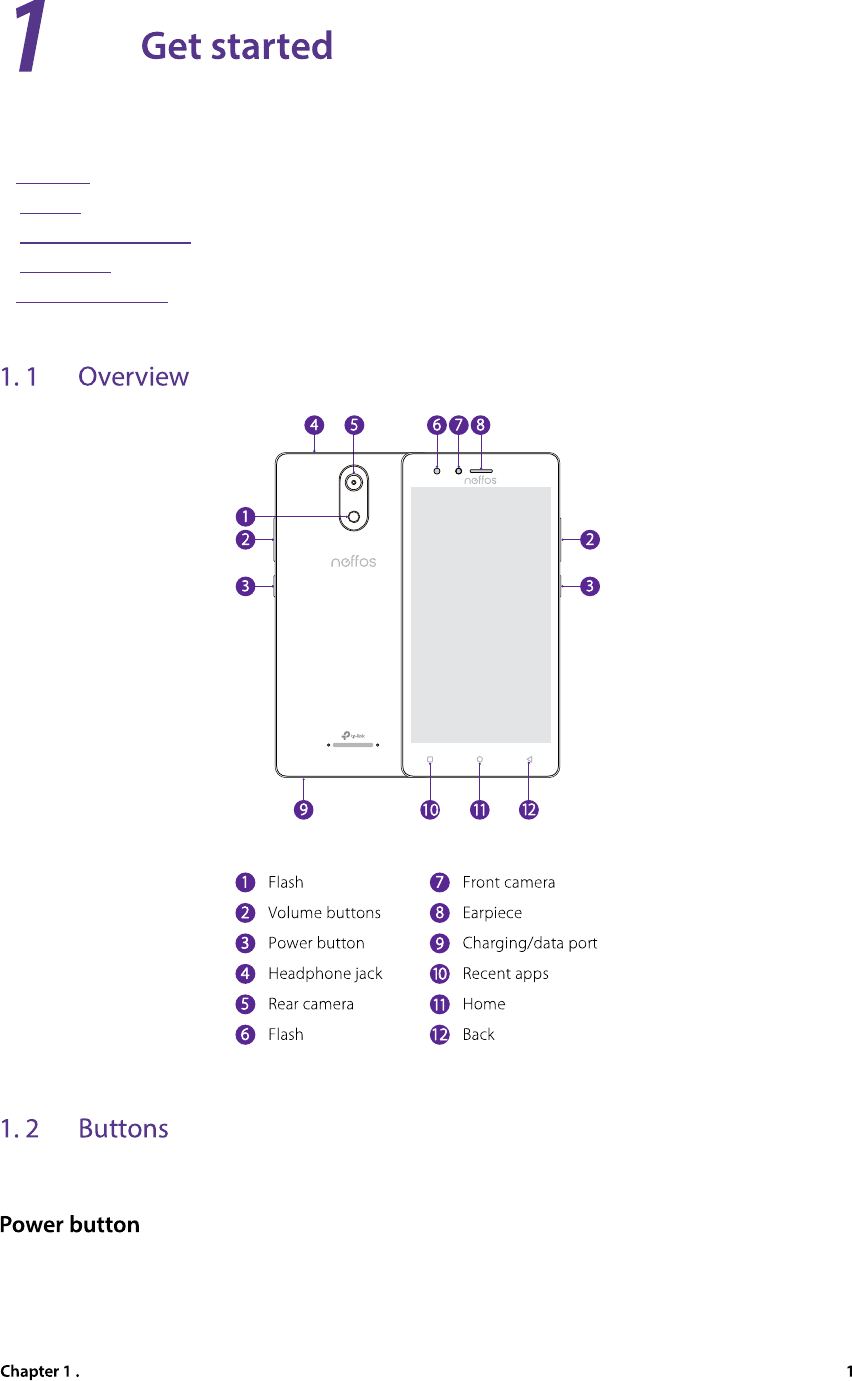
Get started
This chapter introduces the smart phone’s hardware information and guides you how to
assemble your phone when you get started on using your new phone.
• Overview
• Buttons
• Assemble your device
• Initial setup
• Charge your phone
The buttons you use with Neffos include virtual ones and physical ones.
• Lock Neffos: Locking your phone puts the display to sleep, saves the battery and prevents unmeant
operationson the screen. You can still receive phone calls, text messages, alarms and notifications as well
as listening to music and adjusting the volume. Press the Power button to manually lock the screen. Neffos
locks the screen automatically in a given period of inactivity.
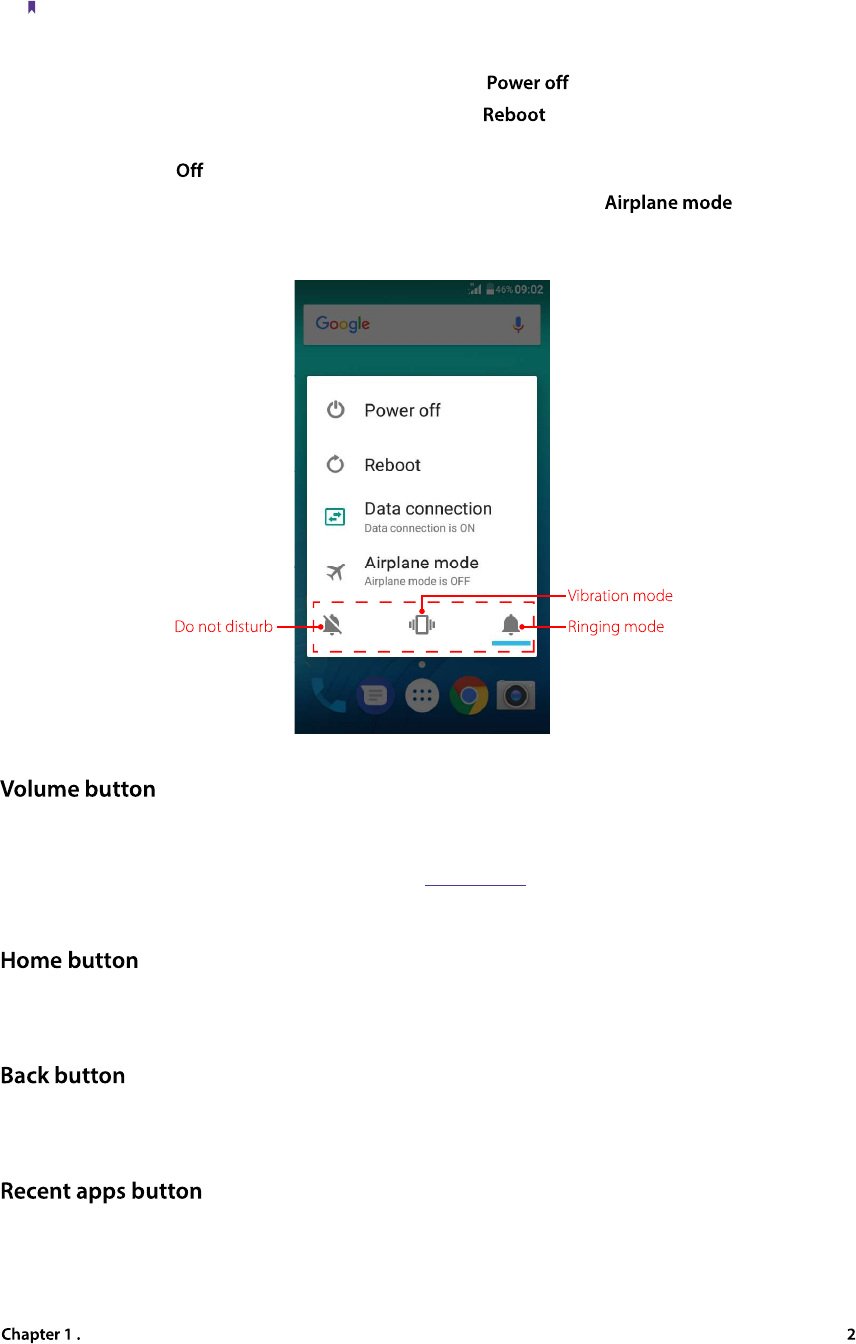
Get started
• Unlock Neffos: Press the Power button to wake the screen.
• Turn Neffos on: Press and hold the Power button until your phone vibrates and the screen turns on.
Note:
If your phone does not respond after holding down the Power button for 10 seconds, the battery may be empty.
Connect your phone to a charger to charge the battery.
• Turn Neffos off: Press and hold the Power button, then tap .
• Reboot Neffos: Press and hold the Power button, then tap .
• Turn on/off data connection: Press and hold the Power button, then choose SIM1/SIM2 to enable data
connection, or tap to disable.
• Enable/disable airplane mode: Press and hold the Power button, then tap .
• Switch between ringing, silent and vibration mode: Press and hold the Power button, and tap the mode
you need.
• Press the Volume-up/Volume-down button to adjust the audio volume when you’re on the phone, listening
to songs, watching movies or using other media.
• Press the Volume button to take a picture. Refer to Take a photo to learn more.
• Press the Power button and Volume-down button at the same time to take a screenshot.
• Tap Home button to return to the default Home screen.
• Touch and hold Home button to open GoogleTM search.
Tap Back button to return to the previous screen or close an application. When entering text, tap Back button
to close the onscreen keyboard.
• Tap Recent apps button to display recently used applications.
• Double-tap Recent apps button to switch to the previous application.
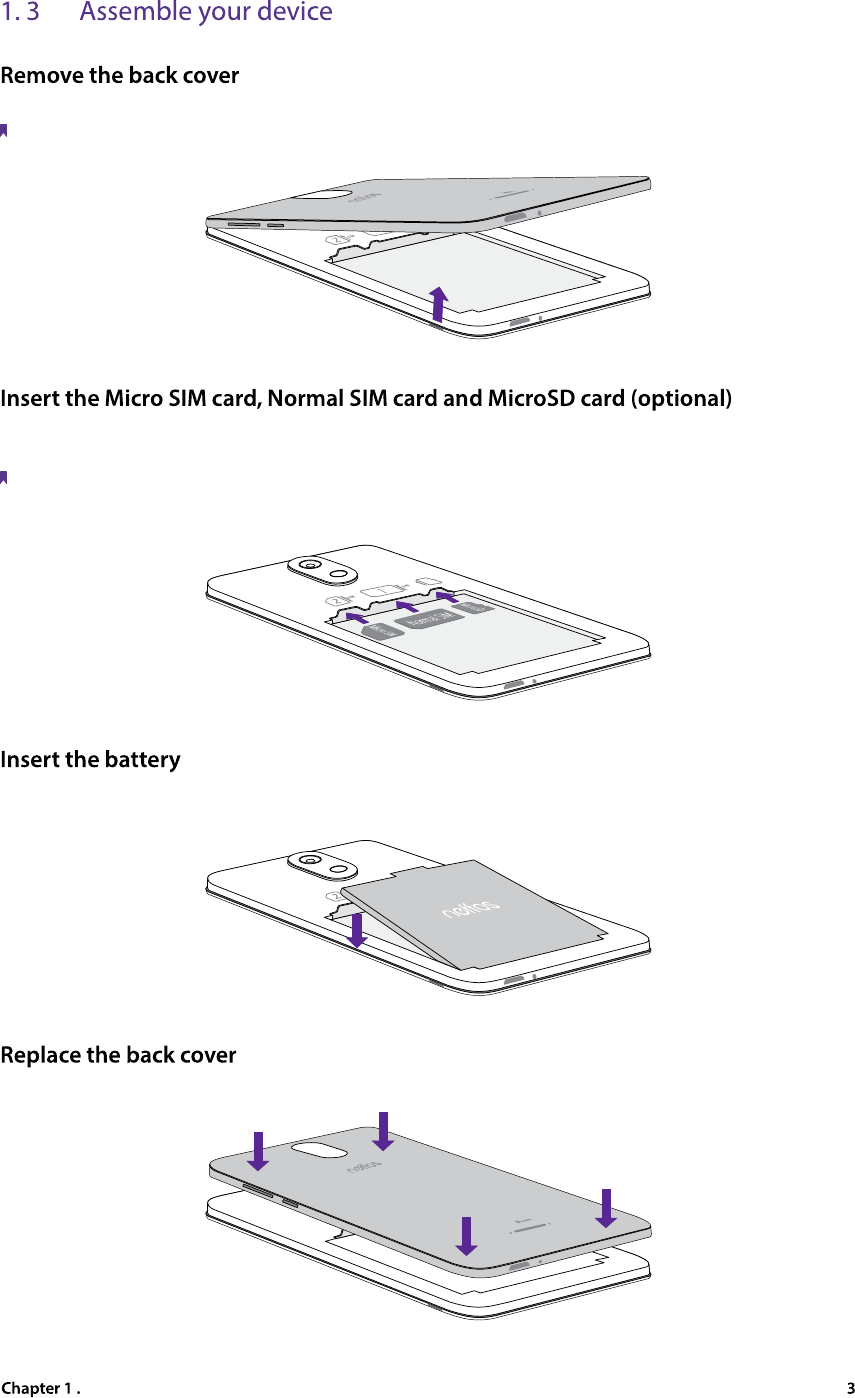
Get started
Hold your phone face down, put a fingernail in the bottom corner hole in the cover and pry the back cover off.
Note:
Do not bend or twist the back cover excessively in case you damage the phone.
Carefully slide the cards into the card slots with the gold contacts facing down. Since your phone is a dual SIM
phone, you can use one or two SIM cards by putting them in the corresponding card slots.
Note:
1. The device supports one Micro SIM card and one Normal SIM card.
2. If the card is not inserted correctly, the phone will not detect them.
Insert the battery into the opening on the back of the phone, aligning the gold contacts on the battery with the
gold contacts in your phone. Then gently press down to secure the battery.
Align the cover and press all the way around the cover’s edges, making sure it snaps into place.
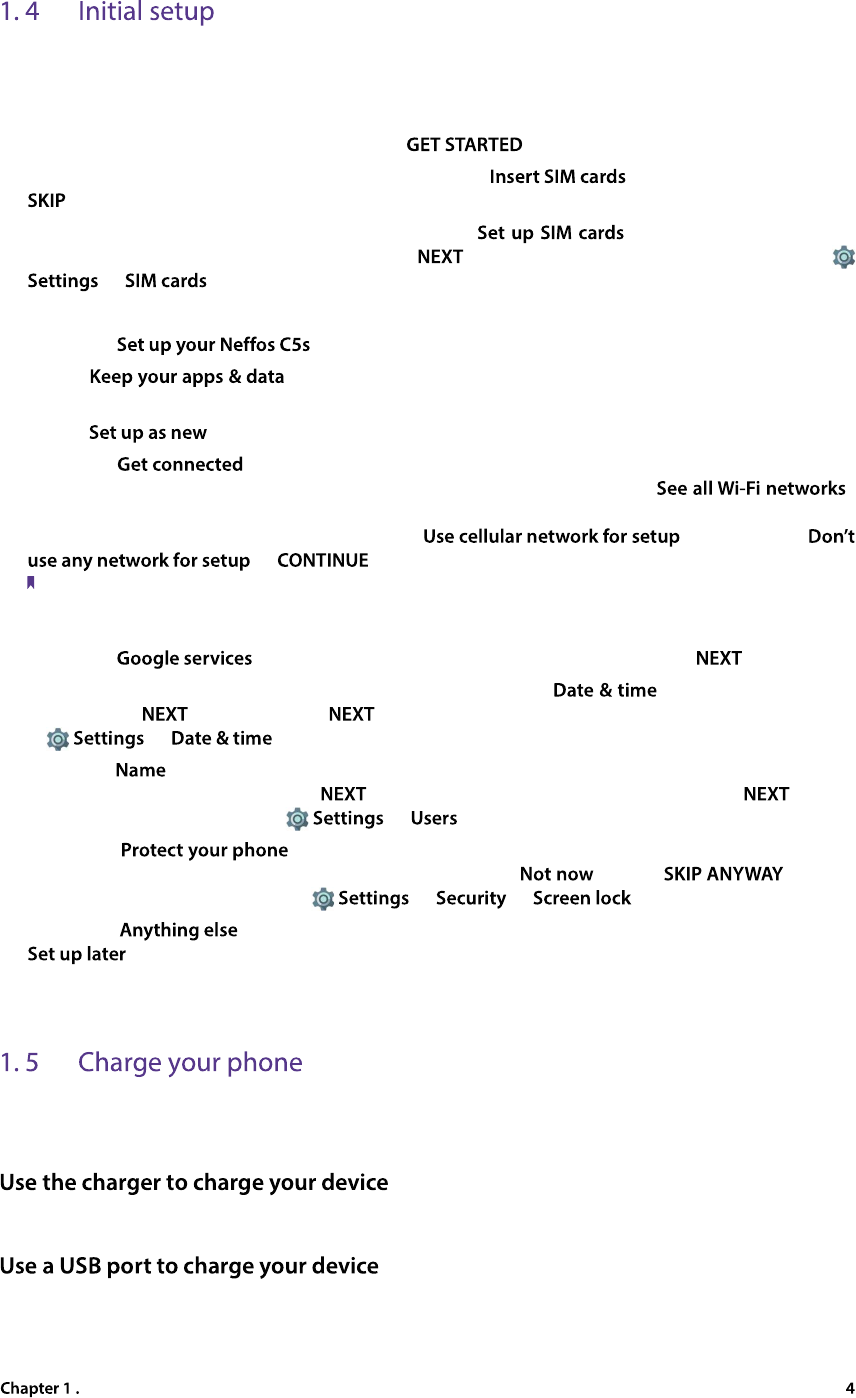
Get started
It is recommended to insert your SIM card before you start the initial setup.
Press and hold the Power button to turn on your phone, and then follow the onscreen instructions to complete
the initial setup.
1.
Select your language and location, and then tap
.
2.
If you don’t insert any SIM card, your device will proceed to
screen. Read the tips and tap
.
If you insert two SIM cards, your device will proceed to
screen. Follow the onscreen
instructions to finish dual-SIM settings and tap
. You can always adjust dual-SIM settings in
->
.
If you insert only one SIM card, your device will skip this step automatically.
3.
Proceed to
screen. You can configure your device in following two ways:
•
Tap
and follow the onscreen instructions to restore a backup or copy from a
device.
•
Tap
to skip this step.
4.
Proceed to
screen. Your phone will automatically list available WLAN networks. Select the
network you want to connect to (If you want to view more Wi-Fi networks, tap
),
and then enter the password to access the Internet (This can take up to 2 minutes). If you have activated
mobile data services with your carrier, you can tap
. Or you can tap
->
to skip this step.
Note:
Using cellular network for setup may result in additional fees. Contact your carrier for information about your cellular
data plan rates.
5.
Proceed to
screen. Read the Google terms and conditions, then tap
.
6.
If you don’t connect to any networks, your device will proceed to
screen. Set the data and
time, then tap
. You also can tap
directly to skip this step. You can always adjust date and time
in
->
.
7.
Proceed to
screen. Add your name to allow your phone to personalize some apps. Your name will be
saved as the owner’s name. Then tap
after finishing. If you don’t want to set now, tap
directly.
You can always set your name in
->
.
8.
Pcoceed to
screen. Select a device protection feature and then follow the onscreen
instructions to complete. If you don’t want to set now, choose
and tap
. You can
always set your device protection in
->
->
.
9.
Pcoceed to
screen. You can set up a few more things there, or you can just skip by tapping
.
10.
Setup completed. Your phone is ready for use.
Your device displays a low battery warning when the battery is nearly empty. Charge your device immediately
to prevent it from switching off automatically.
Connect the device to a power outlet using the included USB cable and power adapter.
If you do not have access to a charger, you can charge your device by connecting it to a computer with a USB
cable.

Get started
Note:
1. When charging your phone, only use genuine Neffos batteries, chargers, and USB cables. Third-party accessories are a
potential safety hazard and may impair your phone’s performance.
2. Avoid using your phone when it is charging. Do not cover your phone or the power adapter.
3. It is entirely normal that your phone may become warm after prolonged use or when exposed to high ambient
temperatures. If your phone becomes hot to the touch, stop charging it and disable unnecessary features. Place your
phone in a cool location and allow it to cool down to room temperature. Avoid prolonged contact with the surface of
your phone if it becomes hot.
4. A low battery warning will be displayed when the battery level is low. Your phone will turn off automatically when the
battery is nearly empty.
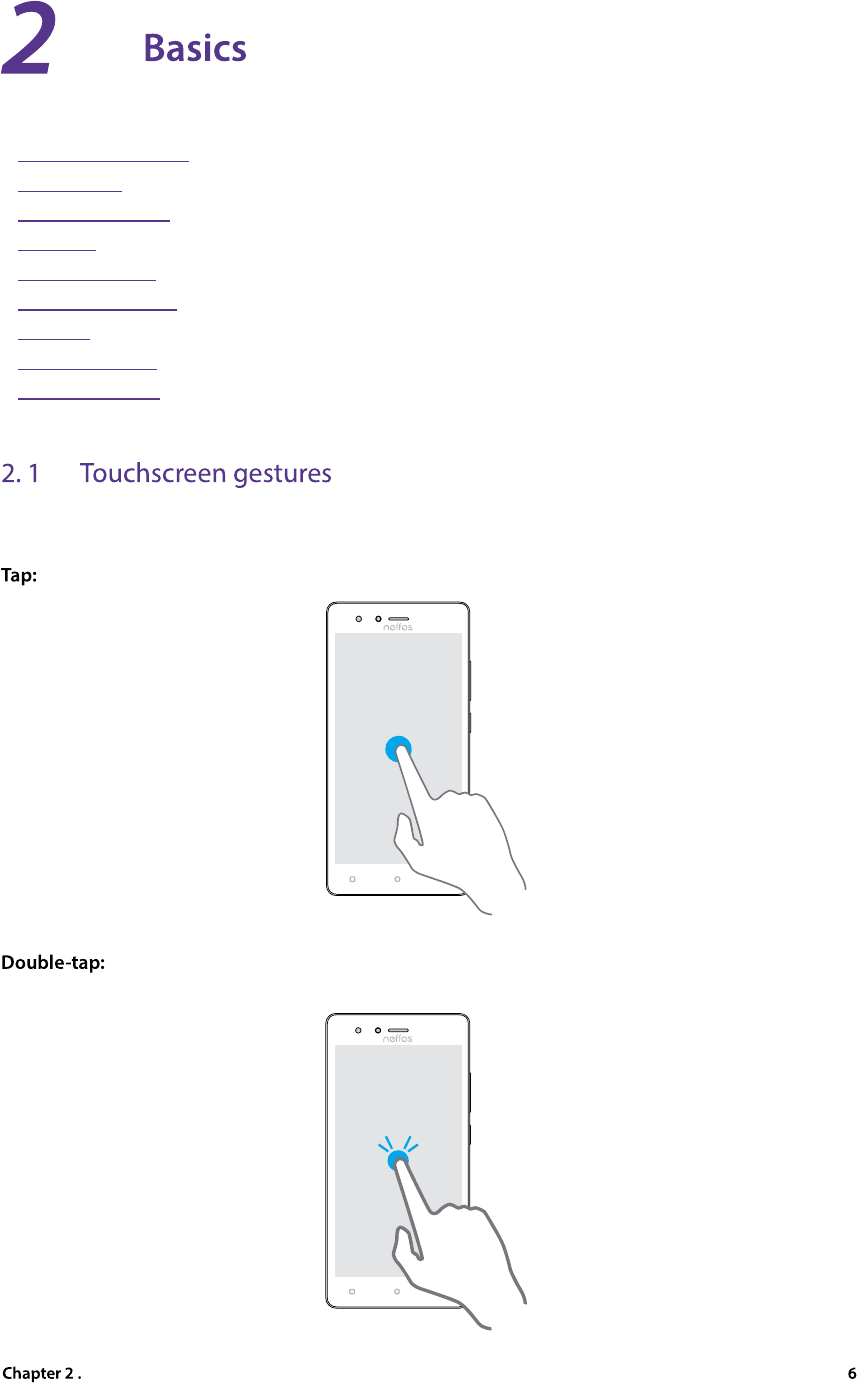
Basics
Learn about your smart phone’s basic feature.
• Touchscreen gestures
• Home screen
• Access applications
• Status bar
• Notification Panel
• Quick Settings Panel
• Type text
• Take a screenshot
• Split-screen mode
Use simple touchscreen gestures to perform a variety of tasks, such as open applications, scroll through lists,
and zoom images.
Simply tap an item once. For example, tap to select an option or open an application.
Tap the target area of the screen twice in quick succession. For example, double-tap an image in
full screen mode to zoom in or out.
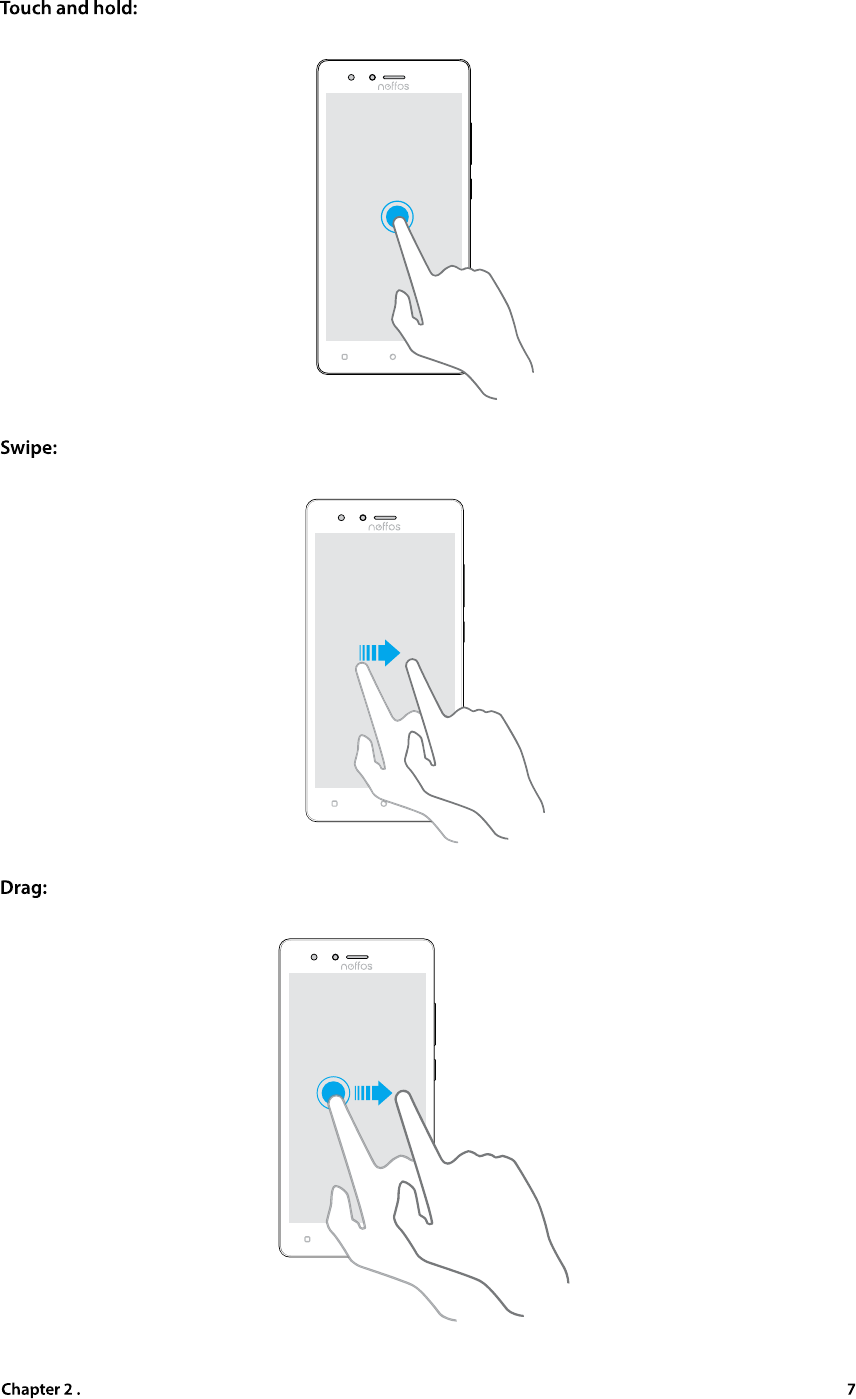
Basics
Touch and leave your finger on the screen for 2 seconds or more to activate onscreen items.
For example, touch and hold a widget on the Home screen to move it.
Place your finger on the screen, and drag your finger to the direction you want. For example, you can
swipe to scroll through the Home screen or a list.
Touch and hold an item and then move it to another position. For example, you can rearrange applications
and widgets on the Home screen.
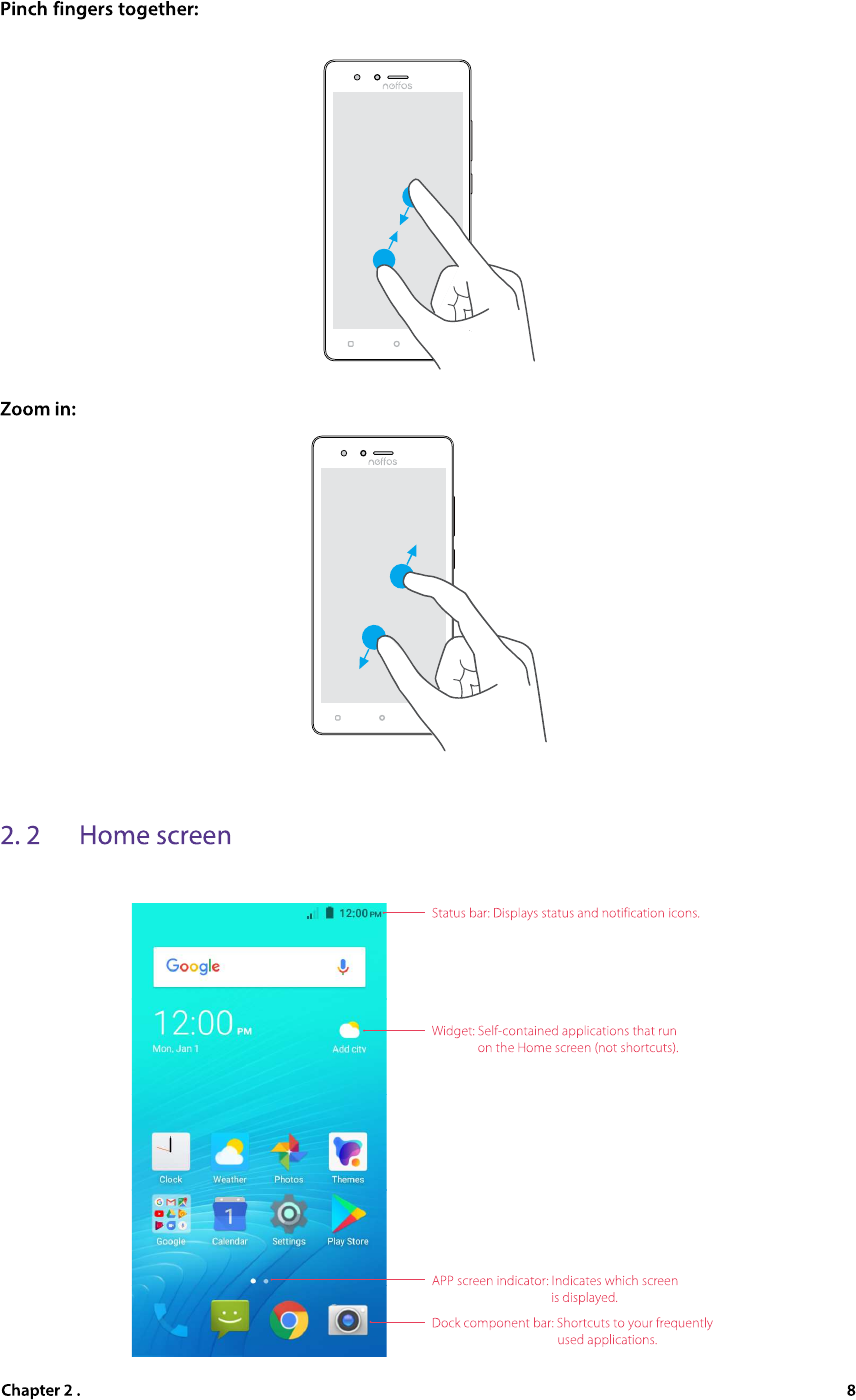
Basics
Pinch two fingers together on the screen. For example, pinch two fingers together
to zoom out on a picture.
Spread two fingers apart on the screen. For example, pinch two fingers out to zoom on a picture.
Your Home screens are where you can find your favorite widgets and all your applications.
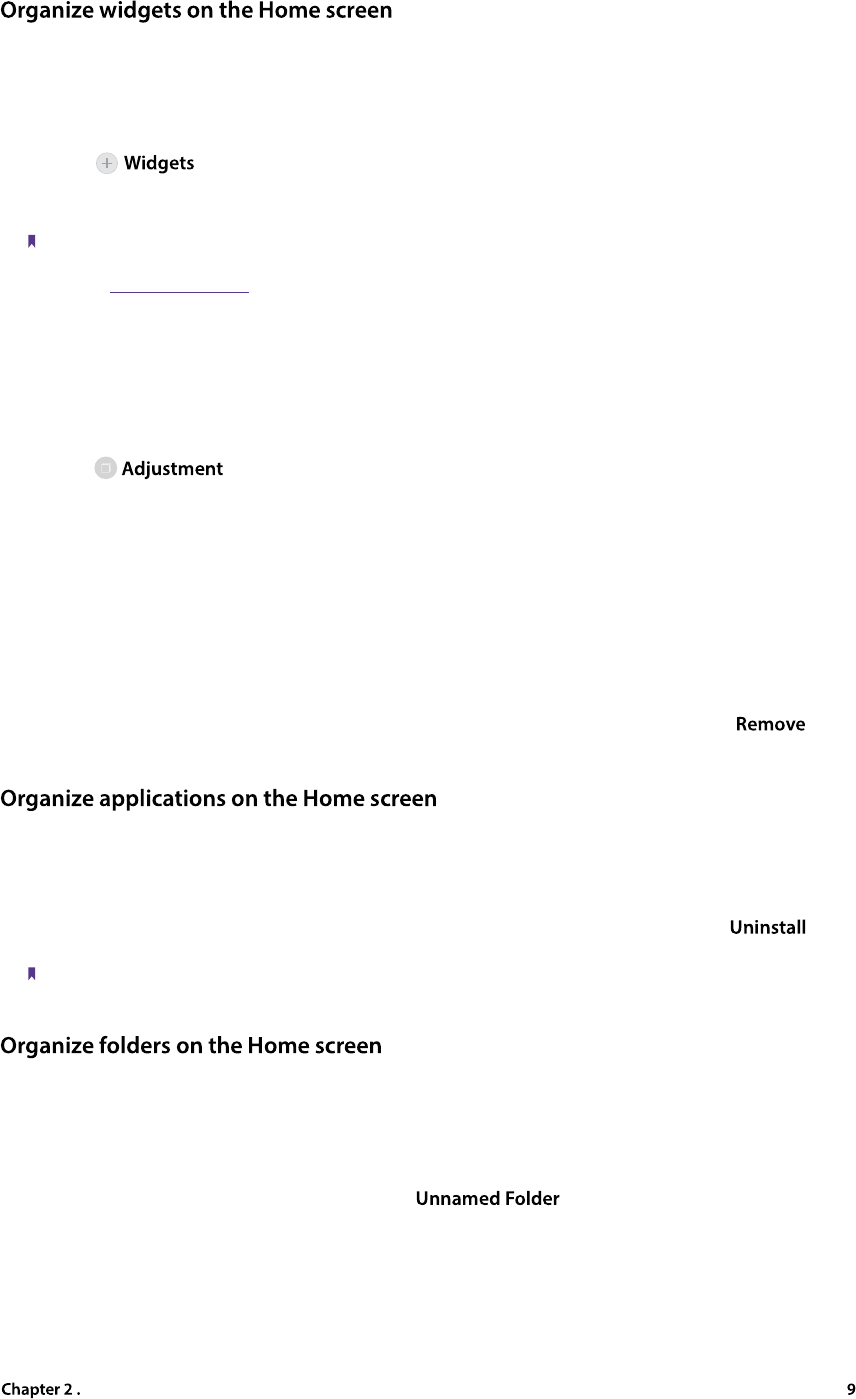
Basics
•
Add a widget to the Home screen
Add frequently used widgets to the Home screen for quick access.
1.
On the Home screen, touch and hold a blank area (or pinch two fingers together) on the screen to
access the Home screen editor.
2.
Tap
and select a widget. Touch and hold the widget and drag it to a blank area on the
Home screen.
3.
Tap a blank area on the Home screen (or tap Home Button/Back button) to quit the Home screen editor.
Note:
You must have enough space on the Home screen to add widgets. If there is not enough space, add another Home
screen (see
Add a Home screen
) or free up some space.
•
Move a widget
On the Home screen, touch and hold an widget and then drag it to the desired location.
•
Batch moving icons
1.
On the Home screen, touch and hold a blank area on the screen (or pinch two fingers together) to
access the Home screen editor.
2.
Tap
. Tap or drag the icons to put them in the adjustment at the bottom.
3.
Swipe left or right to choose the target Home screen.
4.
Tap or drag the icons in adjustment to add them to the target Home screen.
5.
Tap a blank area on the Home screen (or tap Home Button/Back button) to quit the Home screen editor.
•
Adjust a widget size
1.
Touch and hold the widget, and then drag a dot on the contour line to adjust the size.
2.
Tap a blank area (or tap Home Button/Back button) to finish.
•
Delete a widget
On the Home screen, touch and hold the widget you want to delete and then move it to
in the
status bar.
•
Move an application
On the Home screen, touch and hold an application and then drag it to the desired location.
•
Uninstall an application
On the Home screen, touch and hold the application you want to remove, then drag it to
in the
status bar.
Note:
Some pre-installed system applications cannot be removed.
•
Create a folder
Create Home screen folders to organize your applications as desired. For example, you can create a Camera
folder that contains all of your camera applications.
1.
On the Home screen, drag an icon onto another icon to create a folder containing both applications.
2.
To name the new folder, open the folder, tap
and enter the folder name.
•
Rename a folder
On the Home screen, open the folder and touch the folder name, then enter the new name.
•
Add apps to a folder
On the Home screen, touch and hold the application you want to remove, then drag it to the folder you
want to add it to.
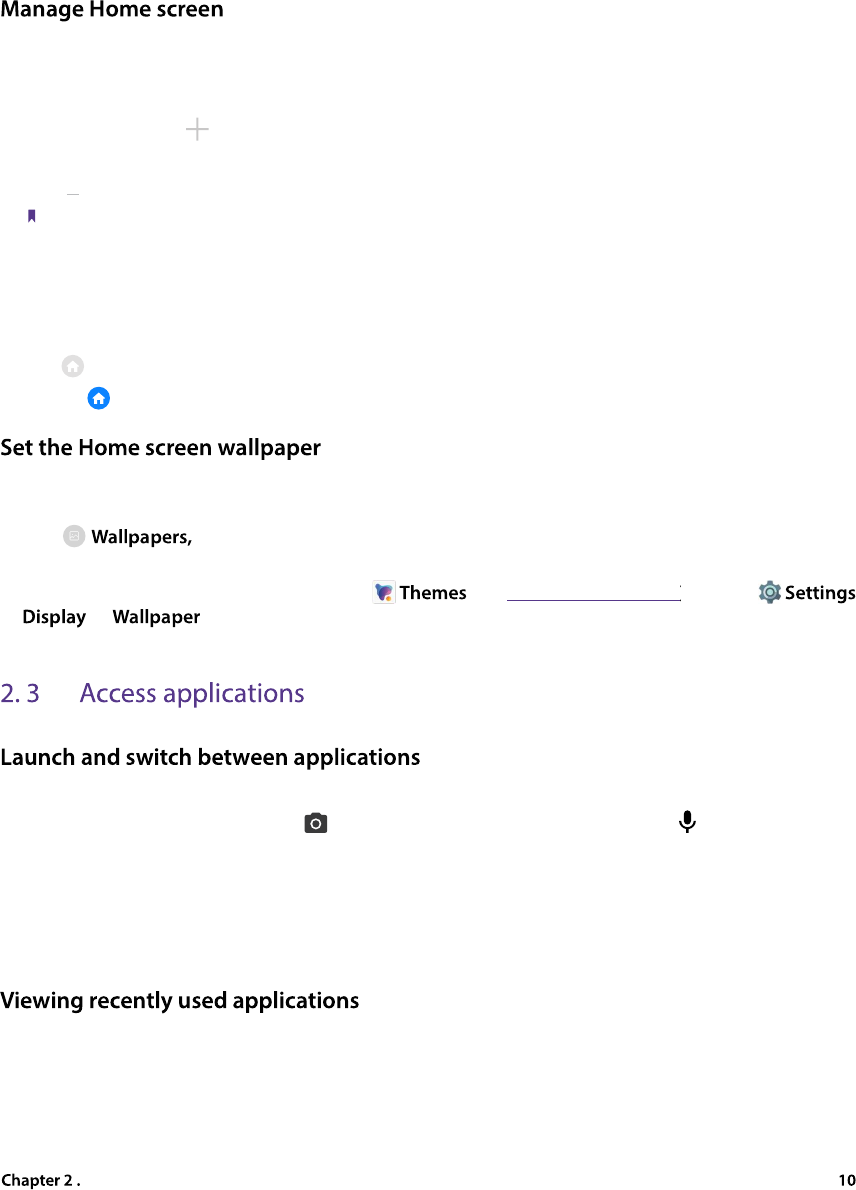
Basics
•
Remove apps from a folder
1.
On the Home screen, open the folder.
2.
Touch and hold the application you want to remove, then drag it out of the folder.
•
Delete a folder
1.
On the Home screen, open the folder.
2.
Remove all the applications in it, then the folder will be automatically deleted.
On the Home screen, touch and hold a blank area on the screen (or pinch two fingers together) to open the
Home screen editor. You can:
•
Add a Home screen
Swipe right and tap
on the rightest screen to add a new screen.
•
Delete a Home screen
Tap
on the Home screen to delete it.
Note:
Only blank Home screen can be deleted.
•
Adjust screen order
Touch and hold the screen you want to move and drag left or right to adjust page order..
•
Set the default home screen
Tap
at the top of a Home screen to set the chosen Home screen as default. On the default Home
screen,
will display at the top.
1.
On the Home screen, touch and hold a blank area (or pinch two fingers together) to open the Home screen
editor.
2.
Tap
and follow the onscreen instructions to set the picture as the Home screen or lock
screen wallpaper (or both).
You also can set the Home screen wallpaper on
(see
Change the wallpaper
), or go to
Change the wallpaper
Change the wallpaper
->
->
.
•
From the Home screen:
Tap an icon to launch the corresponding application.
•
From the Locked screen:
Swipe up
to launch the camera application. Swipe up
to open the Google
assistant.
•
Switch to another application:
Tap the Home button to return to the Home screen, and then tap the
icon of the application you want to open. Or you can tap Recent apps button to view the recently used
applications, then tap the application you want to open. Double-tap Recent apps button to switch to the
previous application.
Tap Recent apps button to display the list of recently used applications.
•
View more applications:
Swipe up or down on the screen to view more recently used applications.
•
Open an application:
Tap a thumbnail to open the corresponding application.
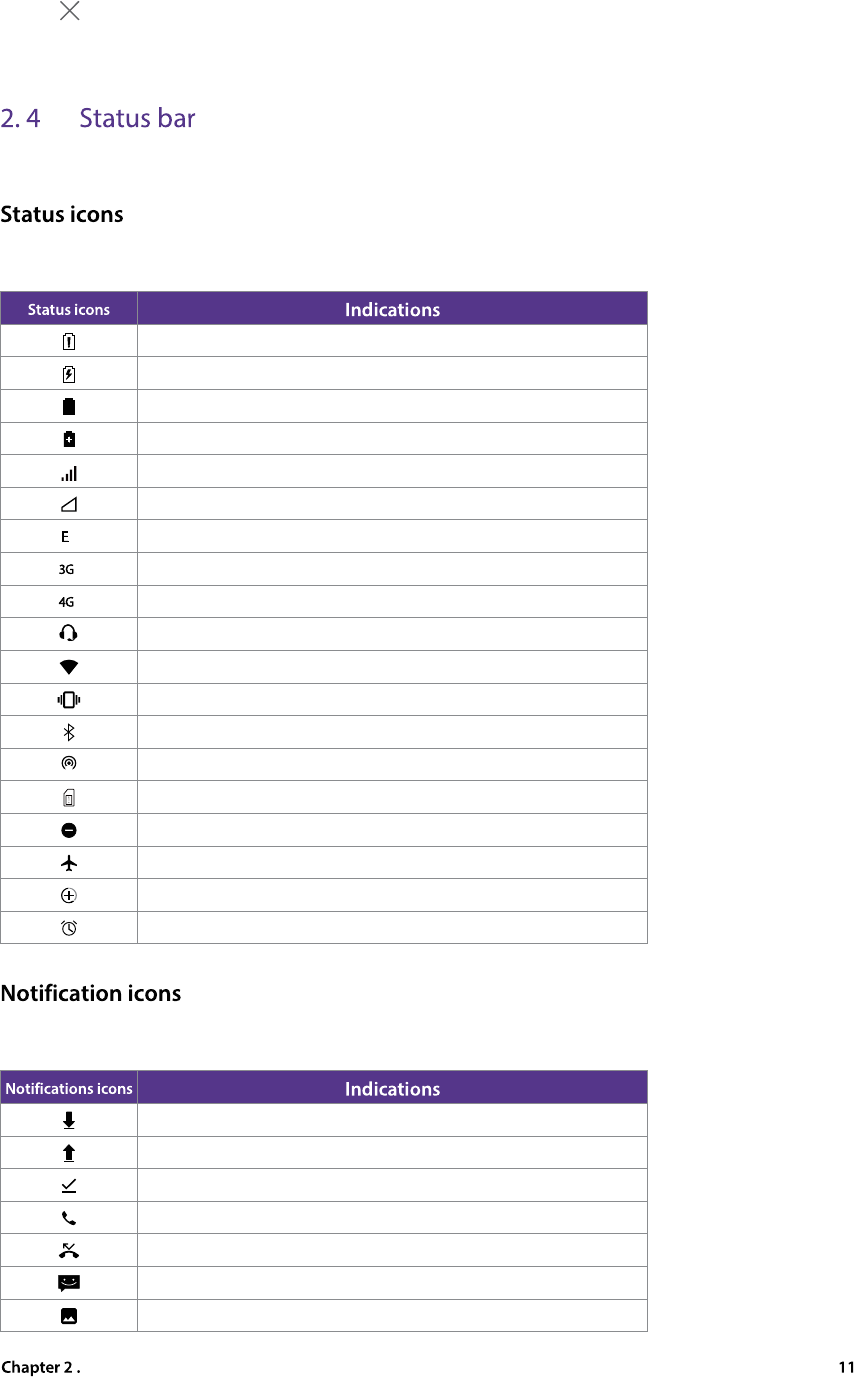
Basics
• Close an application: Swipe left or right on a thumbnail to close the corresponding application, or you can
tap on a thumbnail to close it.
• Close all applications: Tap the button of memory usage to close all applications.
Use the status bar to access the Quick Settings Panel, Notification Panel and check your phone’s status.
Status icons are displayed on the right-hand side of the status bar and tell you about your phone’s status,
including network connections, signal strength, battery, and time.
Battery low
Charging
Battery full
Battery saver enabled
Signal strength
No signal
Connected over GPRS
Connected over 3G
Connected over LTE
Headset mic inserted
WLAN
Vibrate mode enabled
Bluetooth enabled
Hotspot enabled
No SIM card installed
Do not disturb enabled
Airplane mode enabled
Data saver
Alarms enabled
Notification icons are displayed on the left-hand side of the status bar when you receive a new message and
other notifications.
Downloading status
Uploading data
Download complete
Call in progress
Missed calls
New messages
Screenshots
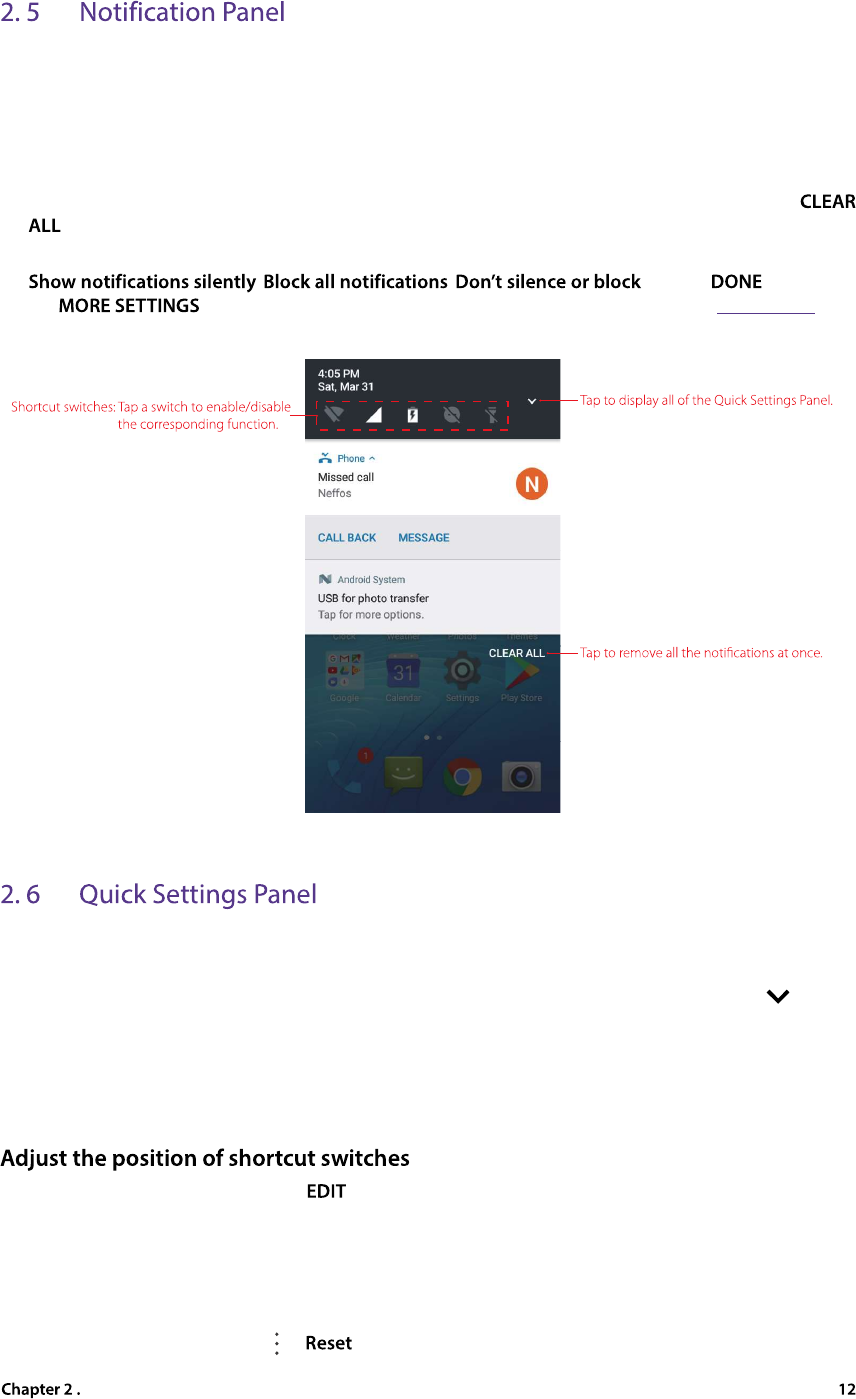
Basics
Notification panel collects all the notifications and alerts so that you can review them whenever you like.
•
Open Notification Panel:
Swipe down from the status bar to open the Notification Panel.
•
View a notification:
Tap an item to view the details. New notifications, such as missed calls and messages
are displayed on the Lock screen. From the Lock screen, double-tap it to view the details, or swipe left or
right to remove it.
•
Clear notifications:
Swipe the notification left or right to remove the it from the list. You can also tap
to remove all the notifications at once.
•
Quickly manage notification:
Touch and hold the notification detail to open the quick settings screen. Choose
/
/
and tap
. Or you can
tap
to go to the notification manage page. For more information, see
Notifications
.
•
Close Notification Panel:
Swipe up, or tap the Home button/Back button.
Use shortcut switches on the Quick Settings Panel to enable or disable functions quickly without using a
settings menu.
•
Open the Quick Settings Panel:
Swipe down twice from the status bar, or swipe down and tap
to open
the Quick Settings Panel. On the Lock screen, swipe only once to open it.
•
Use shortcut switches:
Tap the shortcut switches on the Quick Settings Panel to turn the functions on or off.
Touch and hold the shortcut icon to enter the feature’s settings page.
•
Close the Quick Settings Panel:
Swipe up, or tap the Home button/Back button.
Open the Quick Settings Panel and tap
to enter the edit page. You can:
•
Rearrange shortcut switches:
Touch and hold a shortcut switch and then drag the icon to a position of your
choice.
•
Add a shortcut switch:
Drag a shortcut switch from the bottom section of the panel to the top section.
•
Remove a shortcut switch:
Drag a shortcut switch from the top section of the panel to the bottom section.
•
Reset Quick Settings Panel:
Tap
->
to reset the Quick Seetings Panel to default settings.
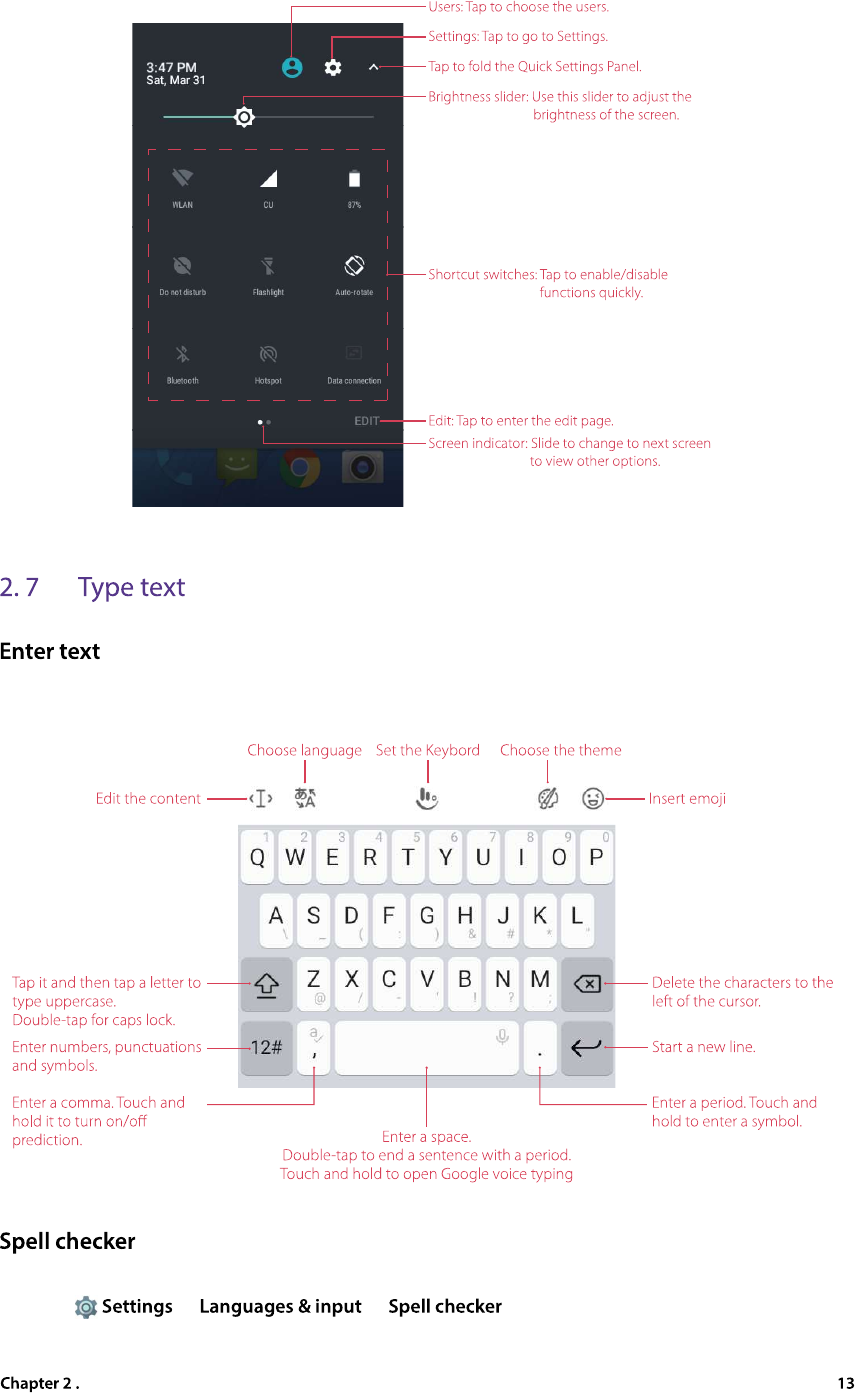
Basics
The keyboard enables you to enter text when needed. Your Neffos C5s use Touchpal by default.
Touch and hold the letter to enter the number or symbol next to it.
You can turn on the Spell checker feature to help you enter correct words.
1.
Go to
->
->
.
2.
Turn on the switch.
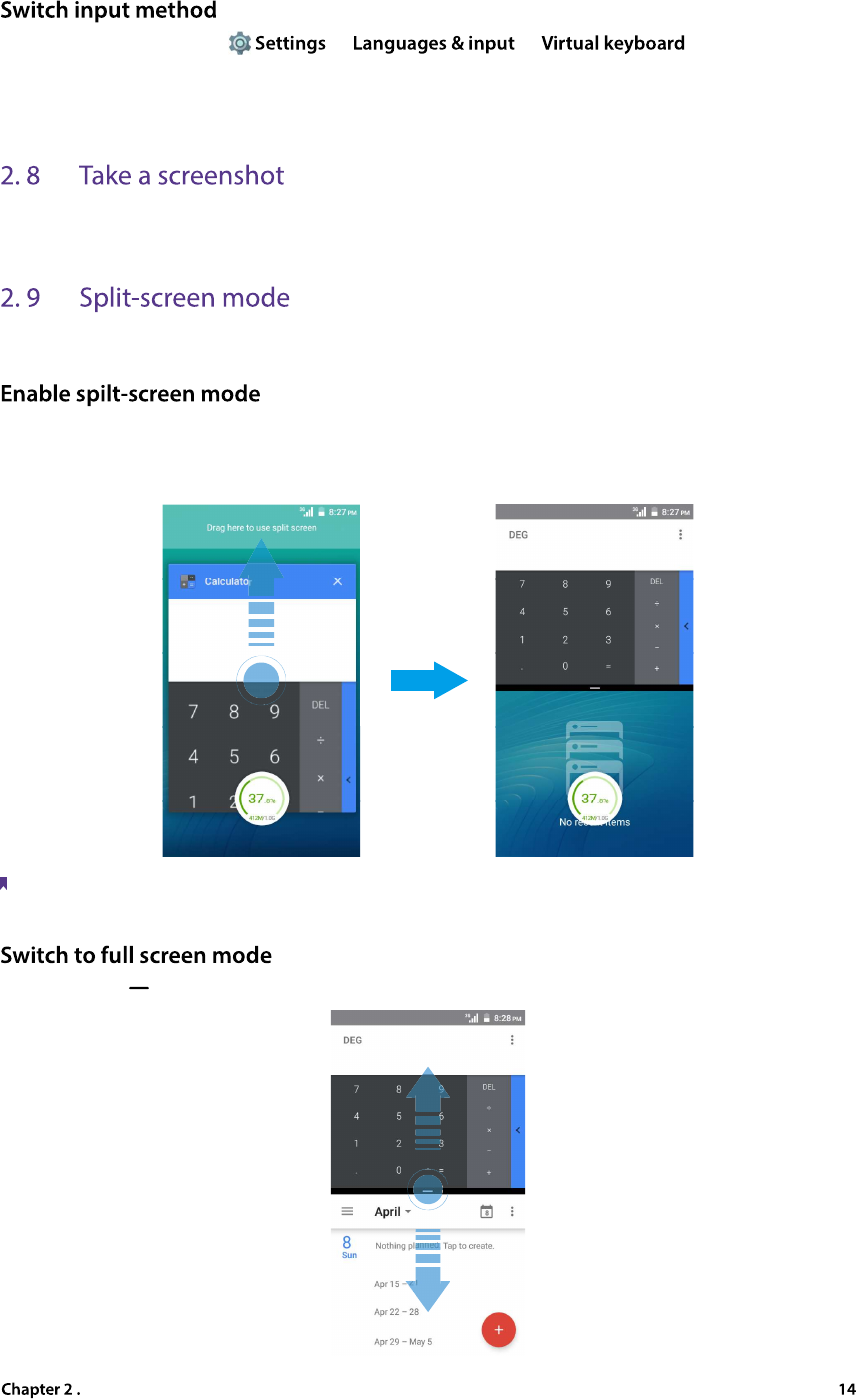
Basics
1.
On the Home screen, tap
->
->
.
2.
Select an input method you need. By default, you can choose Touchpal, Android
TM
keyboard or Google
Voice Typing.
Press the Power button and Volume-down button at the same time to take a screenshot.
Use split-screen mode to use two apps at the same time.
1.
Open an app and tap Recent apps button to open recents apps list.
2.
Touch and hold an app, then drag it up. Then you can open another app, and it will be displayed at the
bottom of the screen.
Note:
Split screen mode is not available for all apps. Some apps may not function properly in split screen mode.
Touch and hold
swipe up or down to switch to full screen mode.
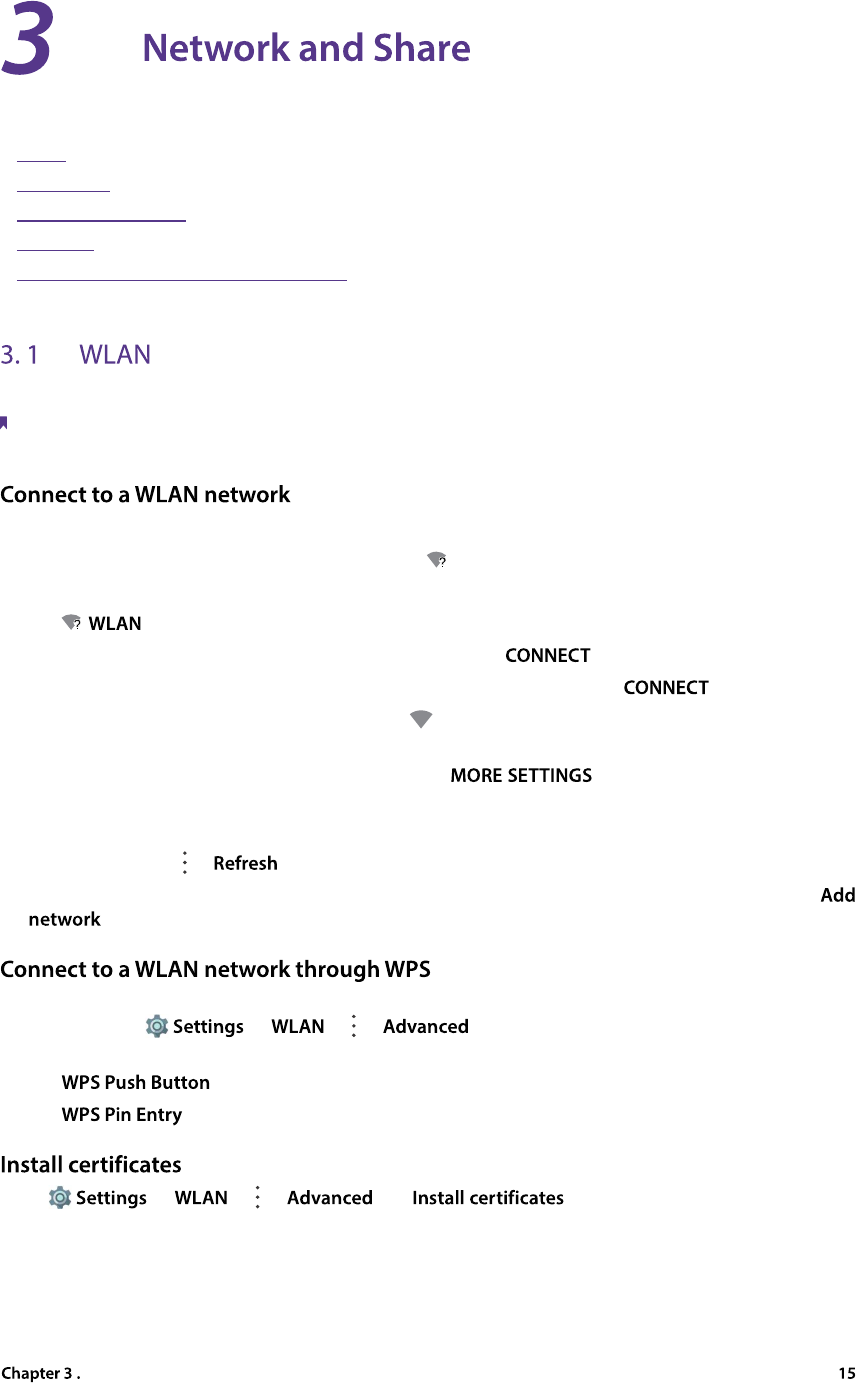
Network and Share
Share your phone data with others by various kinds of connections.
•
WLAN
•
Mobile data
•
Connect to computer
•
Bluetooth
•
Share your mobile data with other devices
Connect to a WLAN network to access the Internet and reduce mobile data usage.
Note:
Your personal data and financial information may be at risk if you connect to insecure public WLAN networks.
Enable WLAN to connect to the Internet using a WLAN acc ess point or hotspot.
When your phone detected available WLAN networks,
will appear in the status bar.
1.
Swipe down twice from the status bar to open the Quick Settings Panel.
2.
Tap
and select the WLAN network you want to connect to:
•
If the Wi-Fi network does not require a password, just tap
.
•
If the network is protected, enter the password when prompted and tap
.
Once your phone is connected to a WLAN network,
will display the icon in the status bar. Your phone will
remember WLAN networks that you have used before and reconnect to them automatically.
If you can’t find the target WLAN network on the list, tap
(or touch and hold WLAN on the
Quick Settings Panel) to proceed to the WLAN settings screen.
On the WLAN settings screen, for more WLAN network, you can:
•
Refresh the list:
Tap
->
to refresh the available WLAN list.
•
Add a WLAN network that is not shown in the list:
Swipe down to the bottom of the list and tap
.Follow the onscreen instructions to configure the WLAN settings and password.
Connecting to a WPS-enabled router over WPS allows you to quickly connect to the network without entering
a password. Go to
->
->
->
and you can connect to your router by following
two ways:
•
Tap
and press the router’s WPS button.
•
Tap
to generate a PIN, and then enter the PIN on the router.
Go to
->
->
->
, tap
and follow the onscreen instructions
to install certificates you need.
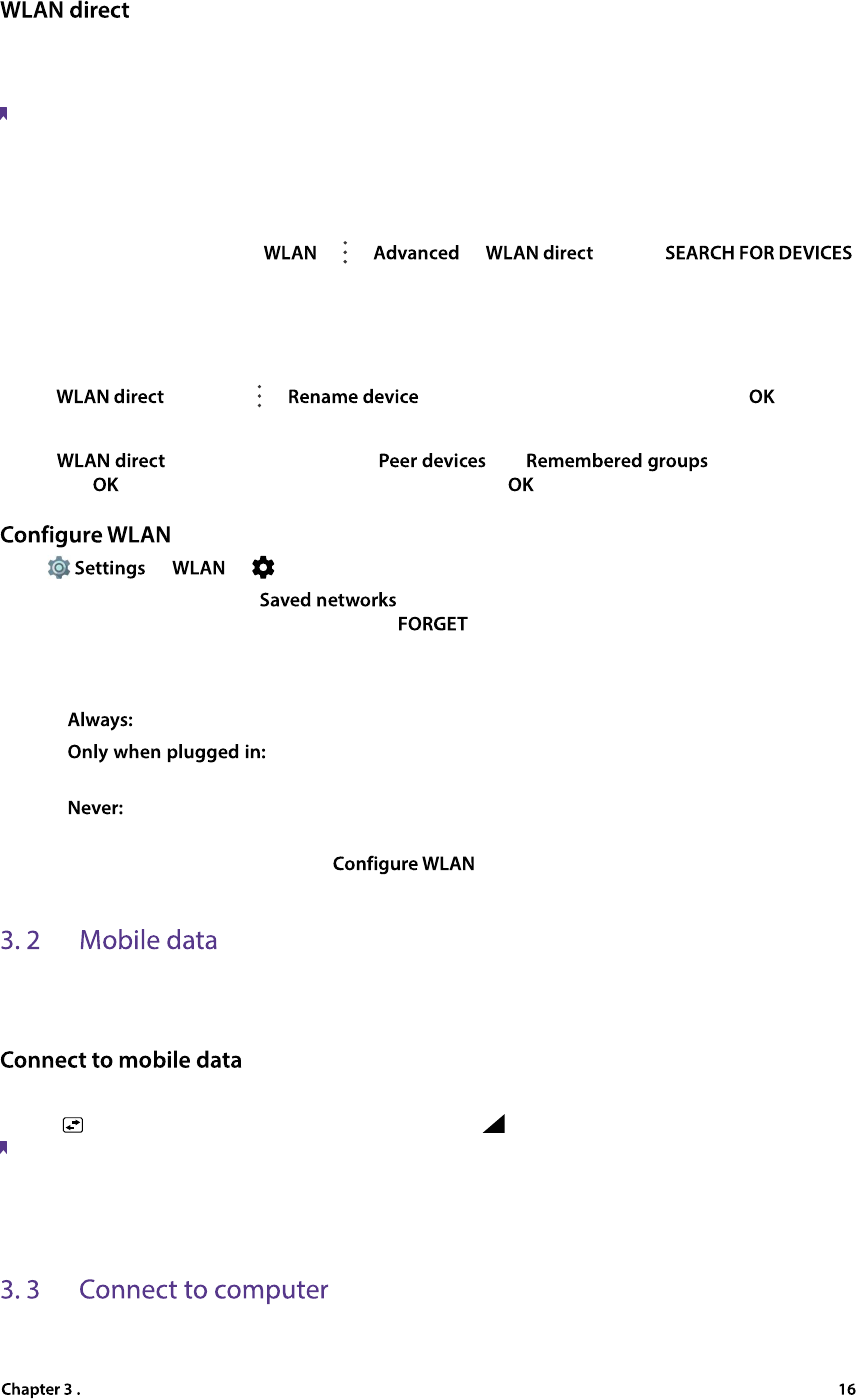
Network and Share
Use WLAN Direct to transfer files between your phone and another device without connecting to a WLAN
network. WLAN Direct is similar to Bluetooth but offers faster transfer speeds, making it suitable for the transfer
of larger files such as videos.
Note:
1.
Using WLAN direct to transfer files needs third-party applications support.
2.
Before using this function, check that both two devices you want to connect support WLAN Direct.
•
Connect two devices using WLAN Direct
:
1.
Swich on WLAN on both two devices.
2.
On your Neffos C5s, go to
->
->
->
, and tap
.
Then keep the Wi-Fi Direct search screen open on both devices.
3.
When your phone detects the other device, select it. Follow the onscreen instructions to establish a
WLAN Direct connection between the two devices.
•
Rename your device:
On
screen, tap
->
. Enter the device name you want and tap
to Save.
•
Manage peer device and remembered groups:
On
screen, you can view your
and
. Tap a peer device
and tap
to disconnect. Tap a remembered group and tap
to forget the group.
Go to
->
->
, you can configure these settings:
•
Manage saved networks:
Tap
to view the networks saved on your phone. Tap to choose
a network to view the details, then you can tap
to remove the network.
•
Network notification:
Turn on the switch, and your phone will notify you when a public network is available.
•
Keep WLAN on during sleep:
There are three options:
1 )
Always stay connected to WLAN when the screen is off.
2 )
When the screen is off, only stay connected to WLAN when your phone is
charging.
3 )
Always switch to mobile data when the screen is off. (When Never is selected, your phone will
disconnect from WLAN and switch to mobile data when the screen turns off).
•
View your MAC and IP address:
On this
screen, you can view your MAC and IP address.
Before using mobile data, ensure that you have a data plan with your carrier to avoid incurring excessive data
charges.
1.
Swipe down twice from the status bar to open the Quick Settings Panel.
2.
Tap
and choose a SIM card for data connection. Or tap
and switch on Cellular data.
Note:
1.
If a WLAN connection to the Internet isn’t available, apps and services may transfer data over your carrier’s cellular
network, which may result in additional fees. Contact your carrier for information about you cellular data plan rates.
2.
When you don’t need to access the Internet, disable mobile data to save battery power and reduce data usage.
Transfer the data on your phone to your computer or transfer the data on your computer to your phone.
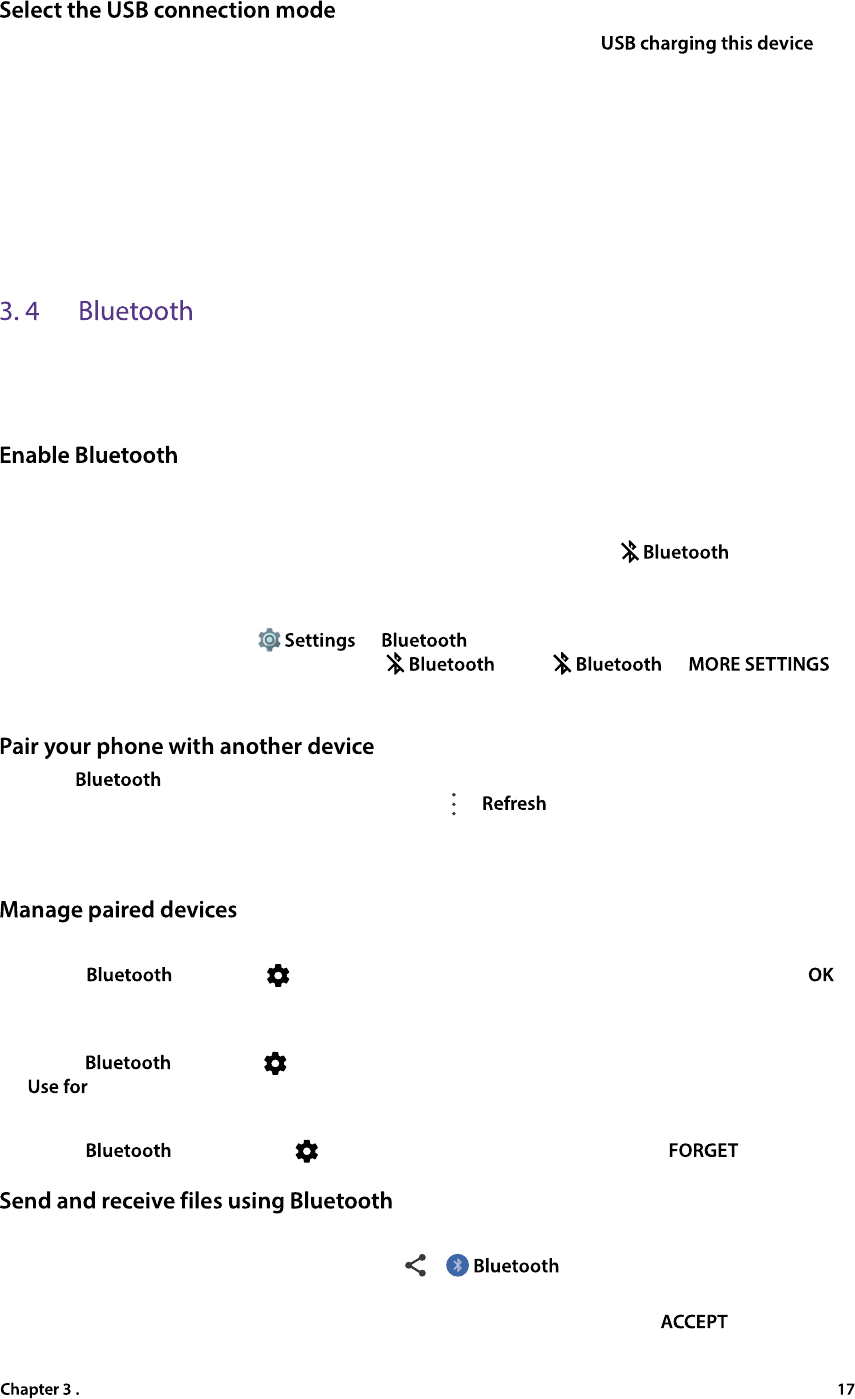
Network and Share
Swipe down from the status bar to open the Notification Panel, and then tap
.
You can choose from the following USB connection modes:
•
Charge this device:
Charge your phone only.
•
Transfer files:
Transfer files between your phone and the computer.
•
Transfer photos (PTP):
Transfer images between your phone and the computer.
•
Use device as MIDI:
Use your phone as a MIDI input device and play MIDI files on the computer.
•
Built-in CD-ROM:
Show a virtual CD-ROM containing some useful software.
You can share data on your phone with other devices using Bluetooth. And you can use Bluetooth to connect
your phone to Bluetooth headsets and in-car Bluetooth to navigate or listen to music while you drive. You can
also connect your phone to Bluetooth wearables to record and manage fitness data.
You can turn on your Bluetooth screen in following ways:
•
On the Quick Settings Panel
:
Swipe down twice from the status bar to open the Quick Settings Panel. Tap
and turn on the
switch.
•
On the Bluetooth screen
:
1.
On the Home screen, tap
->
. Or swipe down twice from the status bar to open
the Quick Settings Panel. Touch and hold
, or tap
->
.
2.
Turn on the switch to enable it.
1.
Go to
screen, your phone will automatically list available devices. If the device you want to pair
with is not displayed, go to Bluetooth settings and tap
->
to refresh the list, or check whether the
device is discoverable.
2.
Select the device you want to pair with and follow the onscreen instructions.
•
Rename paired devices
On the
screen, tap
icon next to the paired device and enter the new name, then tap
to
save.
•
Manage permissions
On the
screen, tap
icon next to the paired device and check/uncheck the premission on the
list.
•
Unpair Bluetooth devices
On the
screen, tap the
icon next to the paired device, and then tap
.
Check that both devices are paired before attempting to transfer files.
•
Send files:
Tap the file you want to send and tap
>
. Your device will automatically search
for nearby devices. Select the receiving device.
•
Receive files:
When another device tries to send you files using Bluetooth, select
from the dialog
box that appears.
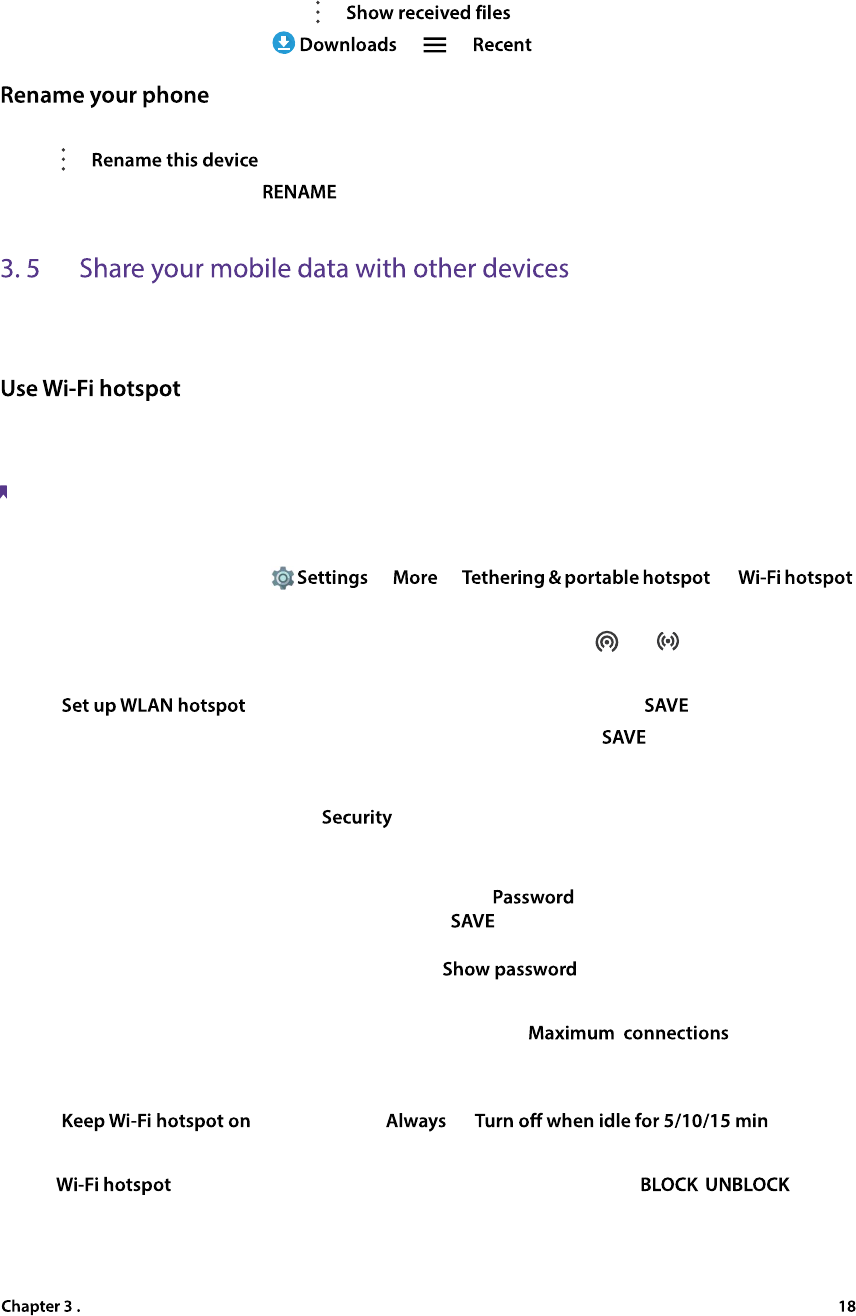
Network and Share
•
View received files
: You can view received files in following ways:
•
Swipe down twice from the status bar to open the Notification Panel. Then tap the downloaded
notification to view file transfer progress.
•
Go to Bluetooth settings and tap
->
.
•
On the Home screen, go to
->
->
.
1.
Go to Bluetooth settings and turn on the switch.
2.
Tap
->
.
3.
Edit the device name and tap
to complete the configuration.
You can share your phone’s mobile Internet with other devices (such as phones, tablets, or computers). The
following Internet sharing methods can be used:
Set up a portable WLAN hotspot to share your phone’s mobile Internet with other devices. Compared with
Bluetooth tethering, the portable WLAN hotspot feature offers quicker, longer range connections, but power
consumption is higher.
Note:
Your device can’t access the Internet using WLAN when your Portable WLAN hotspot is turned on.
•
Open WLAN hotsopt
1.
On the Home screen, go to
->
->
->
.
2.
Turn on the
switch.
3.
After enabling your personal WLAN hotspot, your phone will display
and
icon in the status bar.
•
Set up WLAN hotspot
Tap
to configure following settings. After finishing, tap
.
•
Change the hotspot name:
Enter the name of your hotspot and tap
. The Network name is the
hotspot name. By default, this is the name of your phone model. You can manually change the name to
something that is easier to remember.
•
Change the security setting:
Tap
to configure security setting. Your phone uses WPA2 PSK
encryption by default. Other devices will require a password to connect to the hotspot. If you choose
None, devices will not require a password to connect to the hotspot.
•
Configure a password that is easy to remember:
Tap
and enter the new password (the
password must have at least 8 characters), then tap
. Check Show password to view your password.
The hotspot password is generated randomly by your phone. For security reasons, choose a password
that is not easy to guess. You can check/uncheck
to display/hide your pass word.
•
Select a AP band:
Your device only supports 2.4 GHz Band.
•
Configure the maximum number of connections:
Touch
to change the
maximum number of connections. Your phone will allow up to 8 users to connect to the hotspot.
•
Set the time for keeping WLAN on during sleep
Tap
, you can choose
, or
.
•
Manage users
On
screen, you can view the connected and blocked users. Tap
/
to stop/
allow the connection.
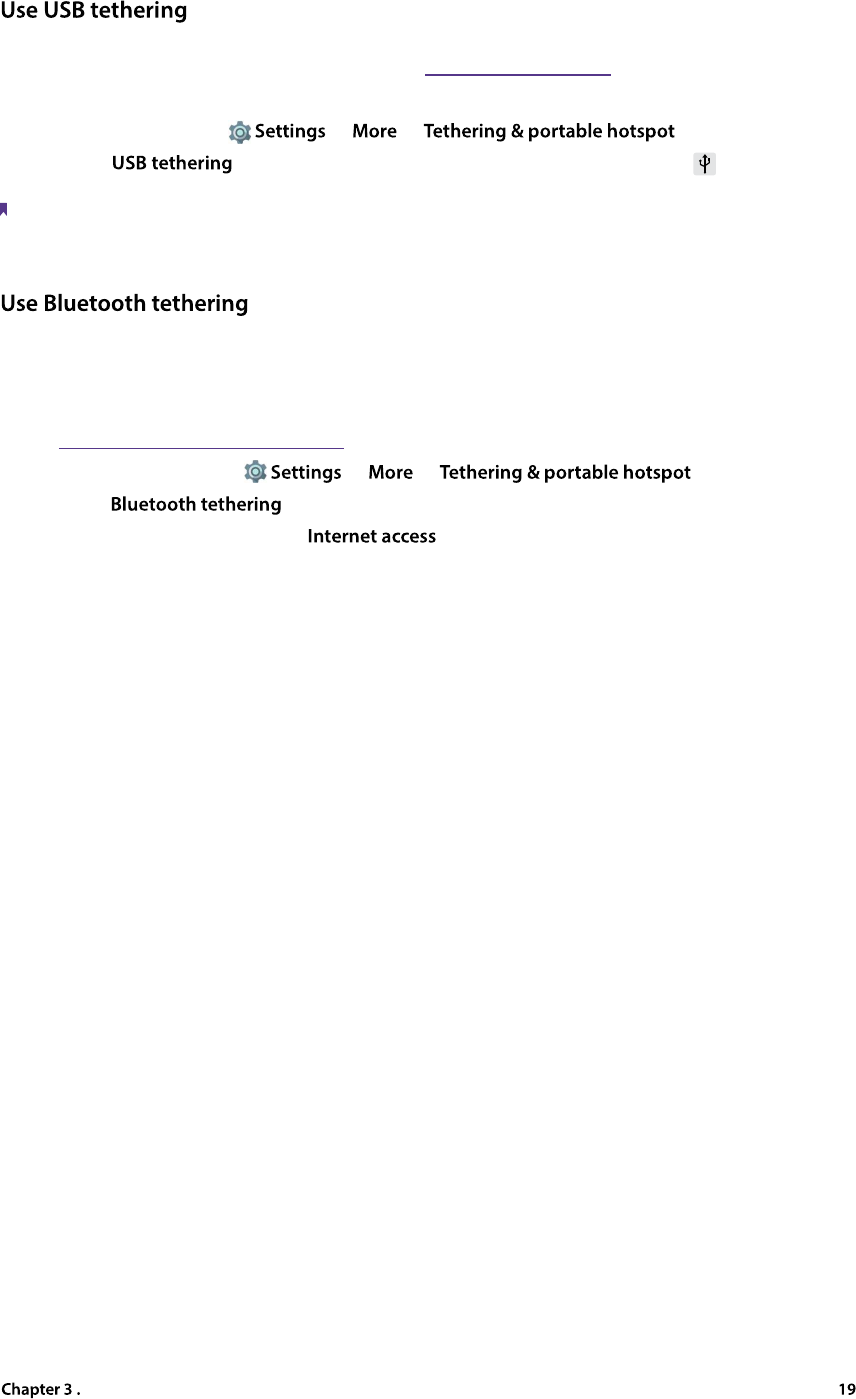
Network and Share
Use a USB cable to share your phone’s mobile Internet with a computer. This is useful if your computer’s Internet
connection stops working. To enable mobile data, see
Connect to mobile data
.
1.
Connect your phone to a computer using a USB cable.
2.
On the Home screen, tap
->
->
.
3.
Switch on
. After enabling USB tethering, your phone will display the
icon in the status
bar. You can then use the computer to access the Internet.
Note:
Depending on your computer’s operating system, you may need to install phone drivers on the computer or establish a
network connection in order to use USB tethering. Please read the instructions for your operating system.
Use Bluetooth tethering to turn your phone into a wireless router and share your mobile Internet with other
devices. Compared with a portable hotspot, Bluetooth tethering offers a slower Internet connection, but
consumes less power.
1.
Establish a Bluetooth connection between two devices and check that they are paired. For more information,
see
Pair your phone with another device
.
2.
On the Home screen, go to
->
->
.
3.
Switch on
.
4.
Go to Bluetooth settings and check
to share your mobile data with the paired device.
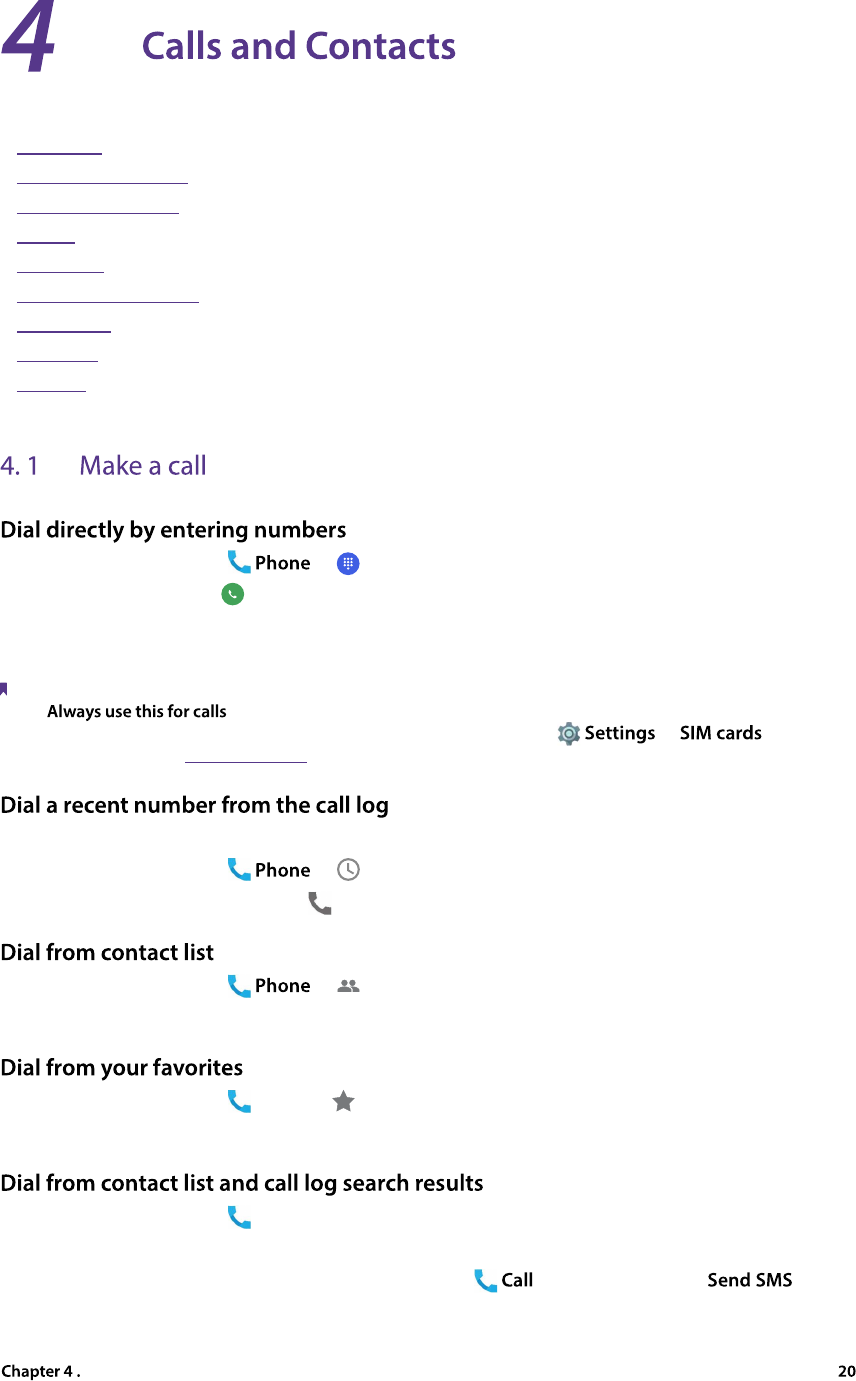
Calls and Contacts
Make calls with your phone to contact one quickly.
•
Make a call
•
Answer or reject a call
•
Options during a call
•
Call log
•
Call History
•
Import/export contacts
•
Call settings
•
Speed dial
•
Contacts
1.
On the Home screen, tap
->
.
2.
Enter a number and tap
to make a call. When you are entering a number, your phone will search your
contacts and call log and list the results above the dialer. Select the contact you want to call. If you have
inserted two SIM cards, and don’t set the default SIM for calls (or set Ask every time), select SIM1 or SIM2 to
dial.
Note:
Check
and tap SIM1/SIM2 to make SIM1 or SIM2 as the default SIM card to make calls. If you want
to change the default SIM card, or if you want to deactivate one of them, go to
->
to configure.
For more information, see
Dual SIM settings
.
All incoming , outgoing and missed call are in the call log.
1.
On the Home screen, tap
->
, a list of recent calls will be displayed.
2.
Select a number or contact and tap
to call.
1.
On the Home screen, tap
->
.
2.
Tap a contact and then tap the number to dial.
1.
On the Home screen, tap
Phone ->
.
2.
Tap the contact directly to make a call.
1.
On the Home screen, tap
Phone.
2.
Tap the search bar and enter the name, initials, or number of a contact.
3.
Tap the contact to dial. If no contact appear, you can tap
to dial directly, or tap
to send
a message to the number.
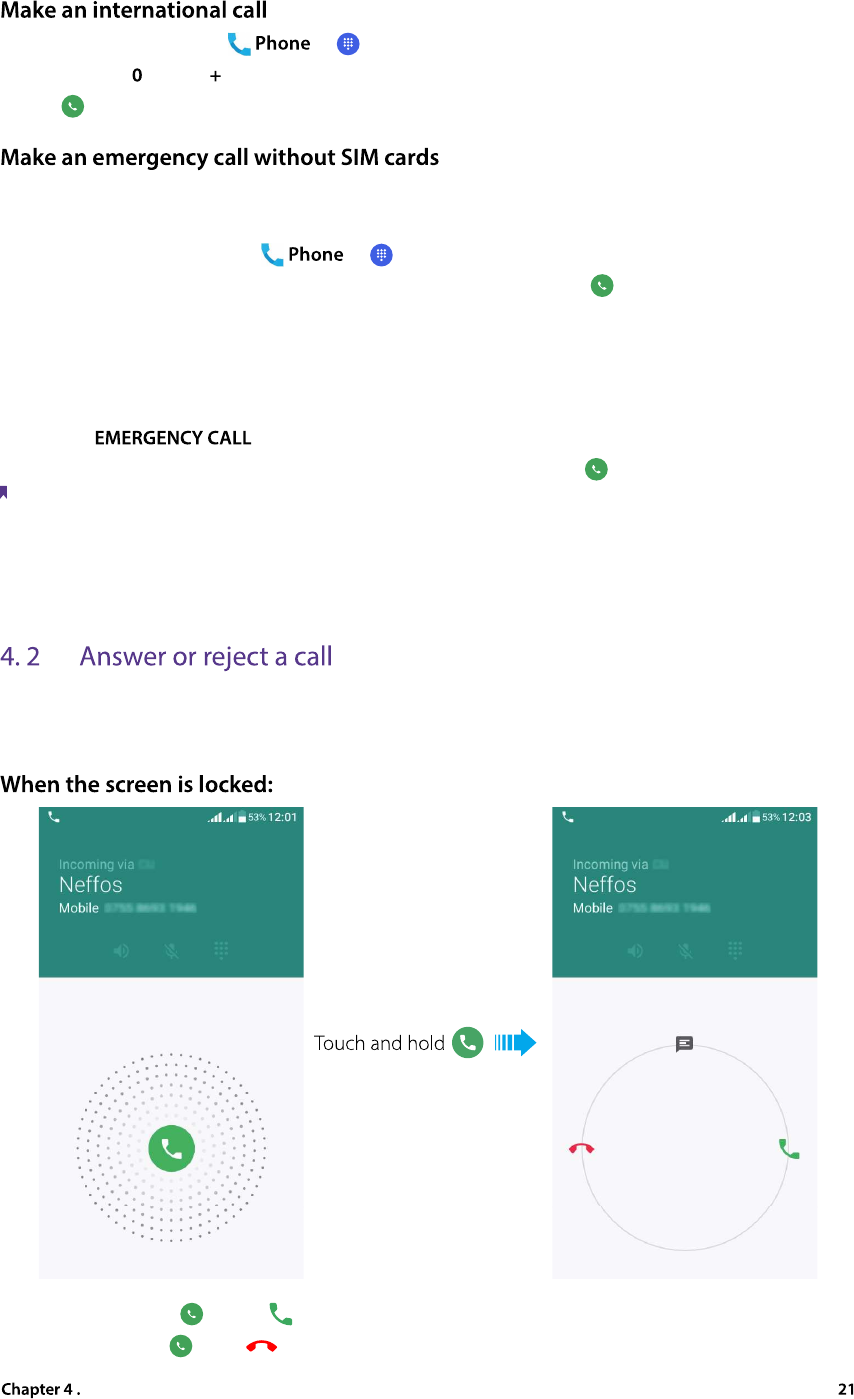
Calls and Contacts
1.
On the Home screen, tap
->
.
2.
Tap and hold
to enter
, then enter the country or region code, area code, and phone number in sequence.
3.
Tap
.
In the event of an emergency, you can make emergency calls from your device, even without a SIM card.
•
Make an emergency from unlock screen
1.
On the Home screen, tap
->
.
2.
Enter the emergency number for your location in the dialer and tap
.
•
Make an emergency from lock screen:
If you enabled the device protection (pattern, PIN or password), you can make an emergency from lock
screen by following way:
1.
Wake up the screen and swipe up on the screen.
2.
Tap
.
3.
Enter the emergency number of your location in the dialer and tap
.
Note:
1.
You must be in an area with cellular coverage, when you have to make an emergency call.
2.
The ability to make emergency calls depends on local regulations and carriers in your area.
3.
Poor network coverage or environmental interference may prevent your call from being connected. Never rely solely
on your device for essential communication during emergencies.
On the incoming call screen:
when a call comes in, you can press the Volume button (or Power button ) to mute the ringtone.
•
Answer a call:
Drag
right to
.
•
Reject a call:
Drag
left to
.
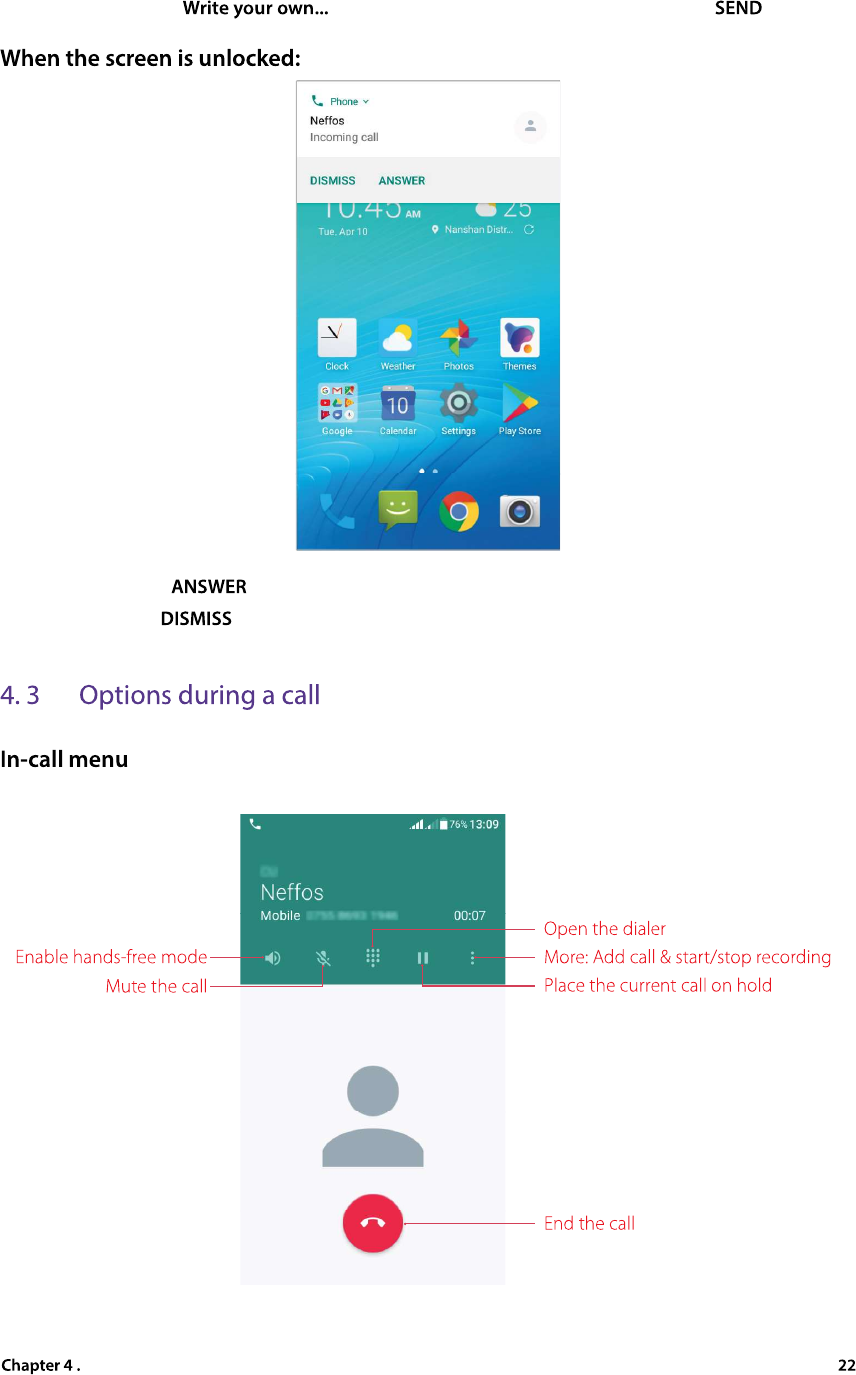
Calls and Contacts
•
Quick response message:
Drag upward to reject the call and select a quick response message to the caller.
Or you also can tap
and enter your own response message, then tap
.
•
Answer a call:
Tap
.
•
Reject a call:
Tap
.
During a call, your phone will display an in-call menu.
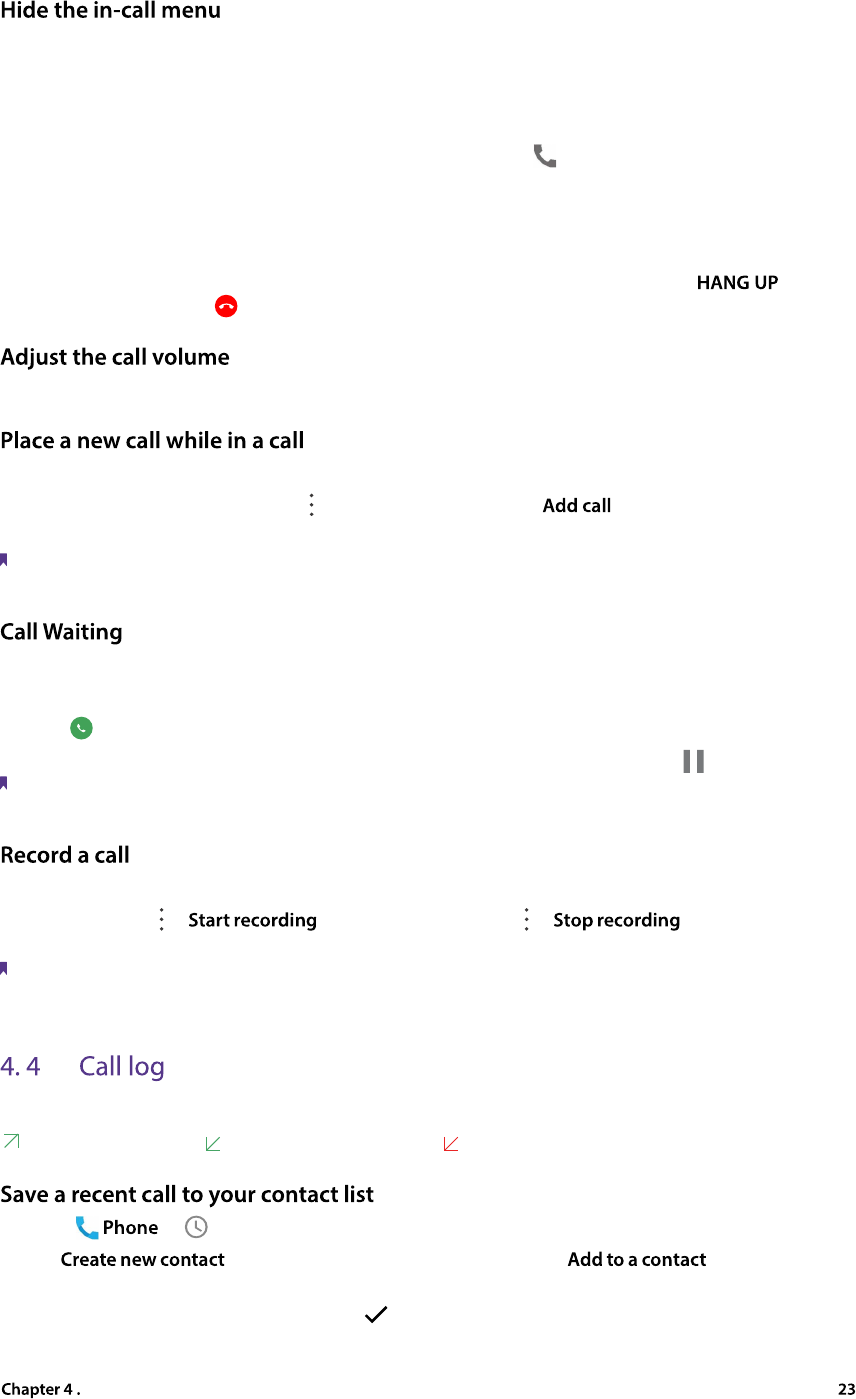
Calls and Contacts
During a call, you can hide the in-call menu and use other applications. The Dialer app will continue to run in
the background.
•
Hide the in-call menu
During a call, tap the Home button or Back button to hide the in-call menu, or tap Recent apps button to
open the list of recently used apps. Then your phone will display
icon in the status bar.
•
Return to the in-call menu
Swipe down from the status bar to open the Notification Panel, tap the call item to return to in-call menu.
•
End a call when the in-call menu is hidden
To end a call, swipe down from the status bar to open the Notification Panel and tap
, or return
to in-call menu and tap
.
Press the Volume button to increase or decrease the volume.
You can make another call while a call is in progress.
1.
While making a call with others, tap
on the in-call menu, and tap
.
2.
Enter another phone number or choose another contact, then tap to dial.
Note:
This function needs the support of local operator. Contact your carrier to find out how to use this feature.
When you want to answer a new incoming call while you are calling someone, you can use Call Waiting function.
When a new call comes in,
1.
Slide
right to answer the new call. The previous call will hold on automatically.
2.
When you want to reactivate the previous call and place the new caller on hold, tap
.
Note:
This function needs the support of local operator. Contact your carrier to find out how to use this feature.
You can record the call while it is in progress.
On in-call menu, tap
->
to start recording, and tap
->
to stop. Recording will
end automatically when the call ends. The recording will be saved to Phone Storage/PhoneRecord by default.
Note:
In some countries, recording during the call is illegal, so their phone may not have this feature.
All incoming, outgoing and missed calls are recorded in the call log.
means outgoing calls,
means incoming calls, and
means missed calls.
1.
Go to
->
, tap the number you want to save.
2.
Tap
to save the number as a new contact, or tap
to add the number
to an existing contact.
3.
Configure the contact information and tap
to save.
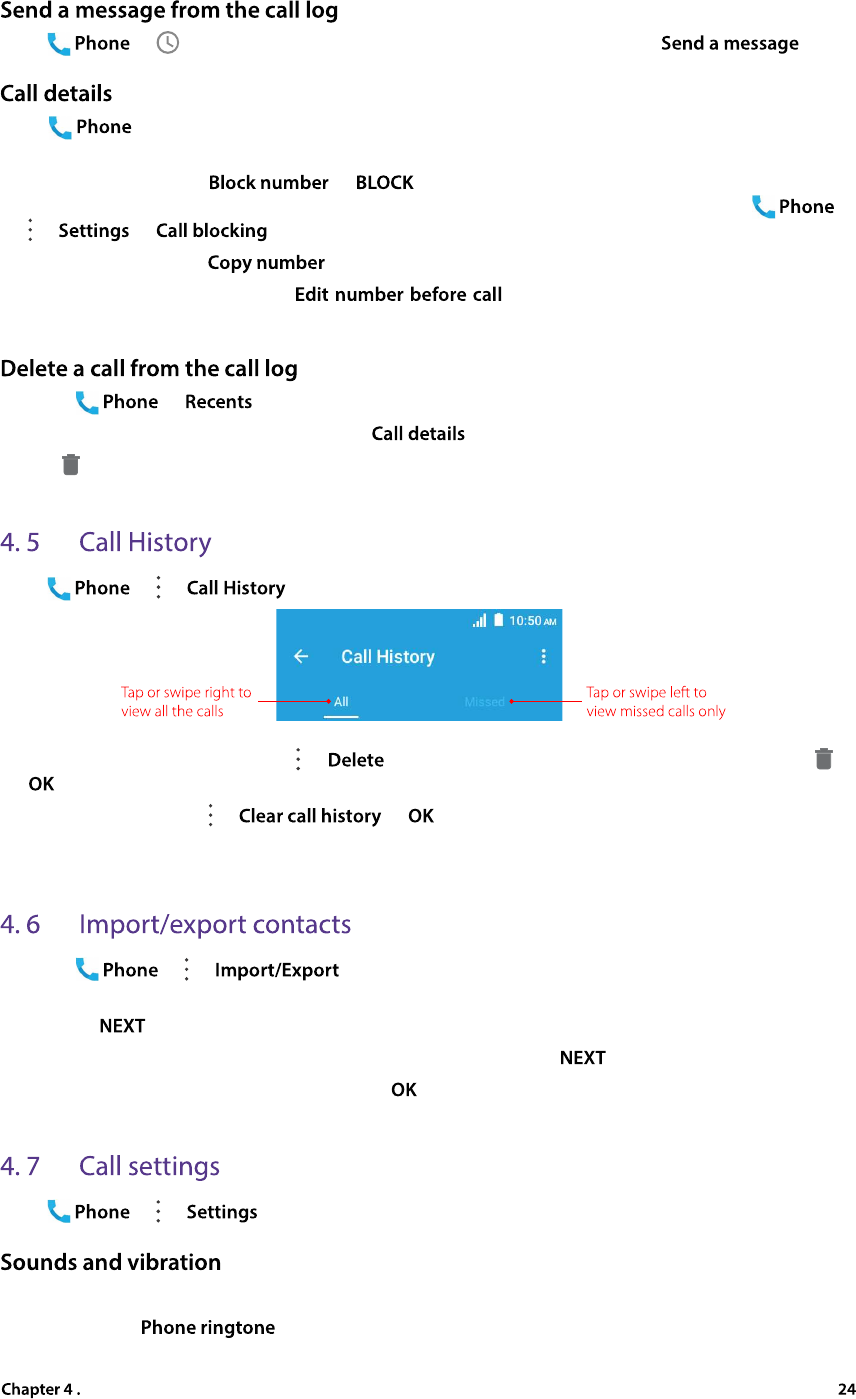
Calls and Contacts
Go to
->
, tap the number/contact you want to send a SMS to, and tap
.
Go to
, tap a number/contact and tap Call details (or touch and hold a number/contact on the call
log), you can:
•
Block the number:
Tap
->
to add the number/contact to black list. And you will no
longer receive calls or messages from the number/contact. You can view blocked number on
->
->
->
.
•
Copy the number:
Tap
to copy the number.
•
Edit the number before call:
Tap
to open the dialer, and the number will be
entered automatically. You can edit it before making a call.
1.
Go to
->
.
2.
Tap the contact you want to delete and tap
.
3.
Tap
to delete.
Go to
->
->
, you can view the call history:
•
Delete call history in batches
: Tap
->
and check the call logs you want to remove, then tap
->
.
•
Detele all call logs
: Tap
->
->
to delete all.
On call history screen, touch and hold a number, you can copy it/edit it before call/block it.
1.
Go to
->
->
.
2.
Choose the storage location you want to copy contacts from (SIM 1/SIM 2/Phone contact/Phone storage)
then tap
.
3.
Choose the storage location you want to copy contacts to, then tap
.
4.
Check the contacts you want to copy, and tap
.
Go to
->
->
to configure the call settings.
Set the phone ringtone, dialpad tones, etc.
•
Ringtone:
Tap
and choose SIM1/SIM2 to set the ringtone you like.
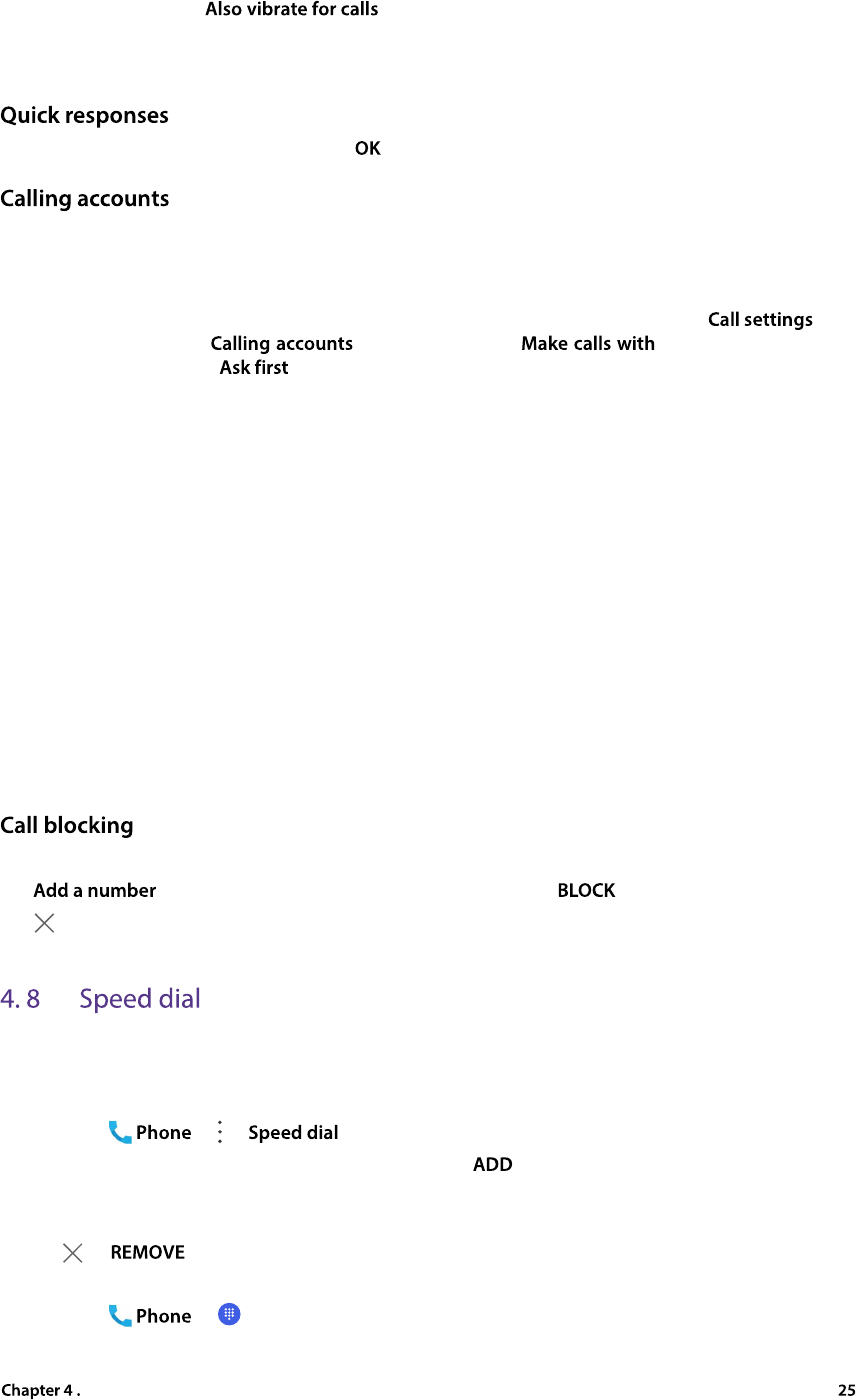
Calls and Contacts
•
Also vibrate for calls:
If
is enabled, your phone will vibrate when receiving incoming
calls.
•
Dialpad tones:
Check to enable dial pad touch tones.
Tap the quick response you want to edit. Tap
after finishing.
Configure your SIM card settings, include voicemail, fixed dialing numbers, call forwarding, call barring and
additional settings.
These features may vary depending on your carrier. For more information about it, contact your carrier.
1.
If you insert two SIM cards and you don’t set the default SIM card for calls, after tapping
, your
device will proceed to
screen. You can tap
to choose SIM1/SIM2 for
making a call, or choose
.
2.
Choose the calling accounts you want to configure, and you can configure following settings:
•
Voicemail:
Divert calls to your voicemail when your phone is switched off or when there is no cellular
coverage. Callers can leave a voice message which you can listen to later. Voicemail must be supported
by your carrier. Please ensure that you have subscribed to this service. Contact your carrier for information
about their voicemail service.
•
Fixed Dialing Numbers:
Use fixed dialing numbers to restrict outgoing calls to whitelisted numbers.
Numbers are added to the FDN list, and when activated, FDN restricts outgoing calls to only those
numbers listed, or to numbers with certain prefixes. When you use the function, you will be asked for
PIN code. To obtain your PIN2 code, contact your carrier. PIN2 must be entered before hand or when
applying such settings, which is unique to each card and initially provided by the network operator.
•
Call forwarding:
If your phone can not answer or you do not want to answer the call, you can transfer
the call to another phone number.
•
Call barring:
Check the box to prevent all or certain calls from reaching to or from your phone number.
•
Additional settings:
Set up your Caller ID (Display your number in outgoing calls) and call waiting (notifiy
you for incoming calls during a call).
View the number you don’t want to receive texts or calls.
Tap
and enter the number you want to block, then tap
.
Tap
beside the number to unblock it.
You can use speed dial to make a call by just one key. This function is particularly useful for you if you dial certain
numbers frequently or on a regular basis.
•
Add a speed dial
1.
Go to
->
->
, tap a figure to add speed dial.
2.
Enter the number or tap to add a contact. Then tap
after finish. You can add up to 8 speed dial
numbers.
•
Delete a speed dial
Tap
->
to detele the speed dial.
•
Make a speed dial
1.
Go to
->
, touch and hold the figure of speed dial number.
2.
Tap the figure and tap the number/contact displayed on screen.
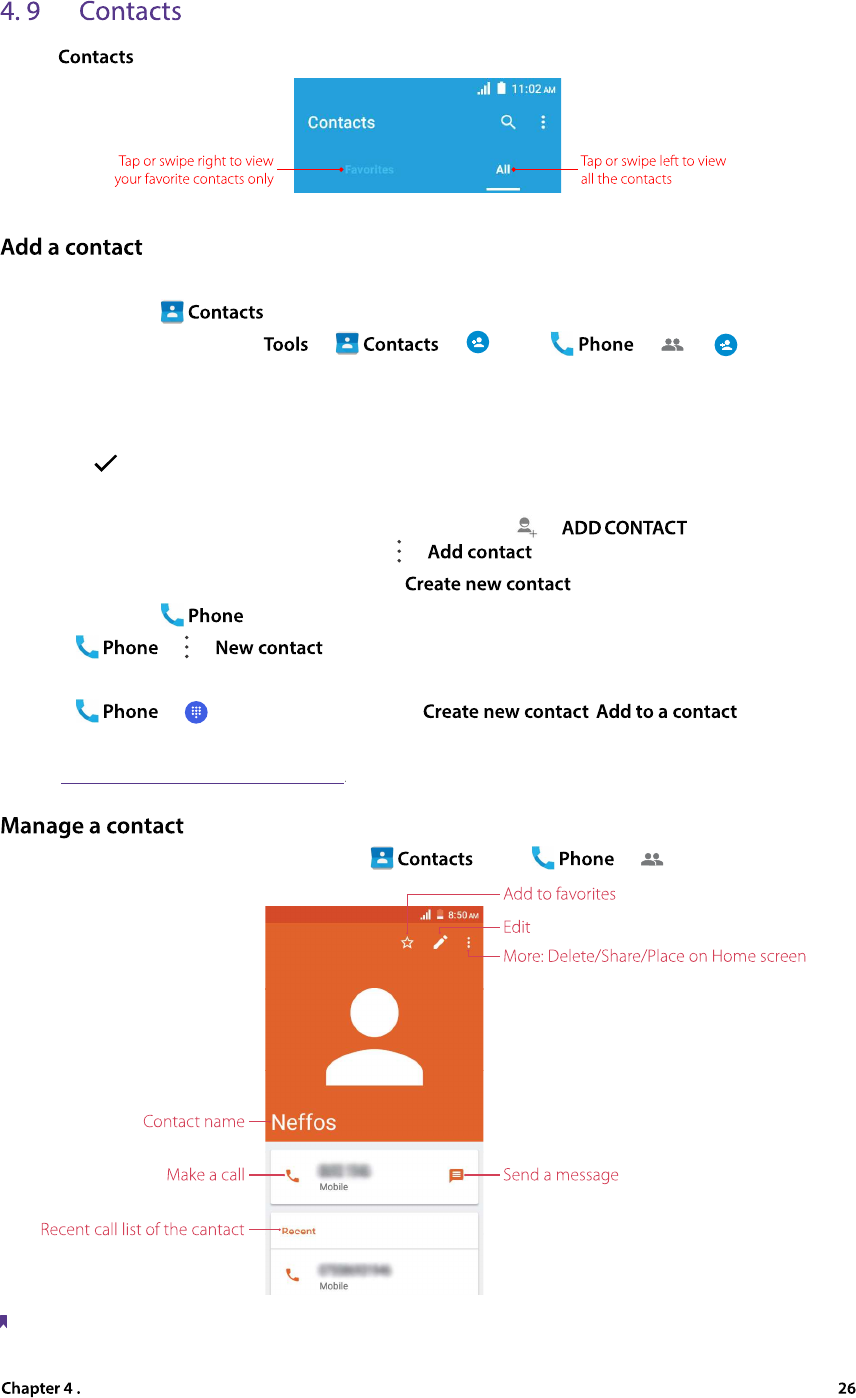
Calls and Contacts
On the
screen:
You can create a new contact or add a number to a contact in following ways:
•
Add a contact in
1.
On the Home screen, tap
->
->
(or tap
->
. ->
) to add a new
contact.
2.
Select the storage location you want to store the contact to.
3.
Enter the contact’s information.
4.
Tap
to save the new contact.
•
Add a contact from message
1.
On the message list, touch and hold a conversation, and tap
->
. Or tap a conversation
to enter the conversation screen. Then tap
->
.
2.
Choose a contact to add the number or tap
.
•
Add a contact in
Go to
->
->
.
•
Add a contact from the dialer
Go to
->
, enter the number and tap
/
.
•
Add a contact from call log
See
Save a recent call to your contact list
.
Save a recent call to your contact list
Save a recent call to your contact list
Go to the contact list
: On the Home screen, tap
, or tap
->
.
Note:
Only phone contacts can be placed on Home screen or added to favorites.
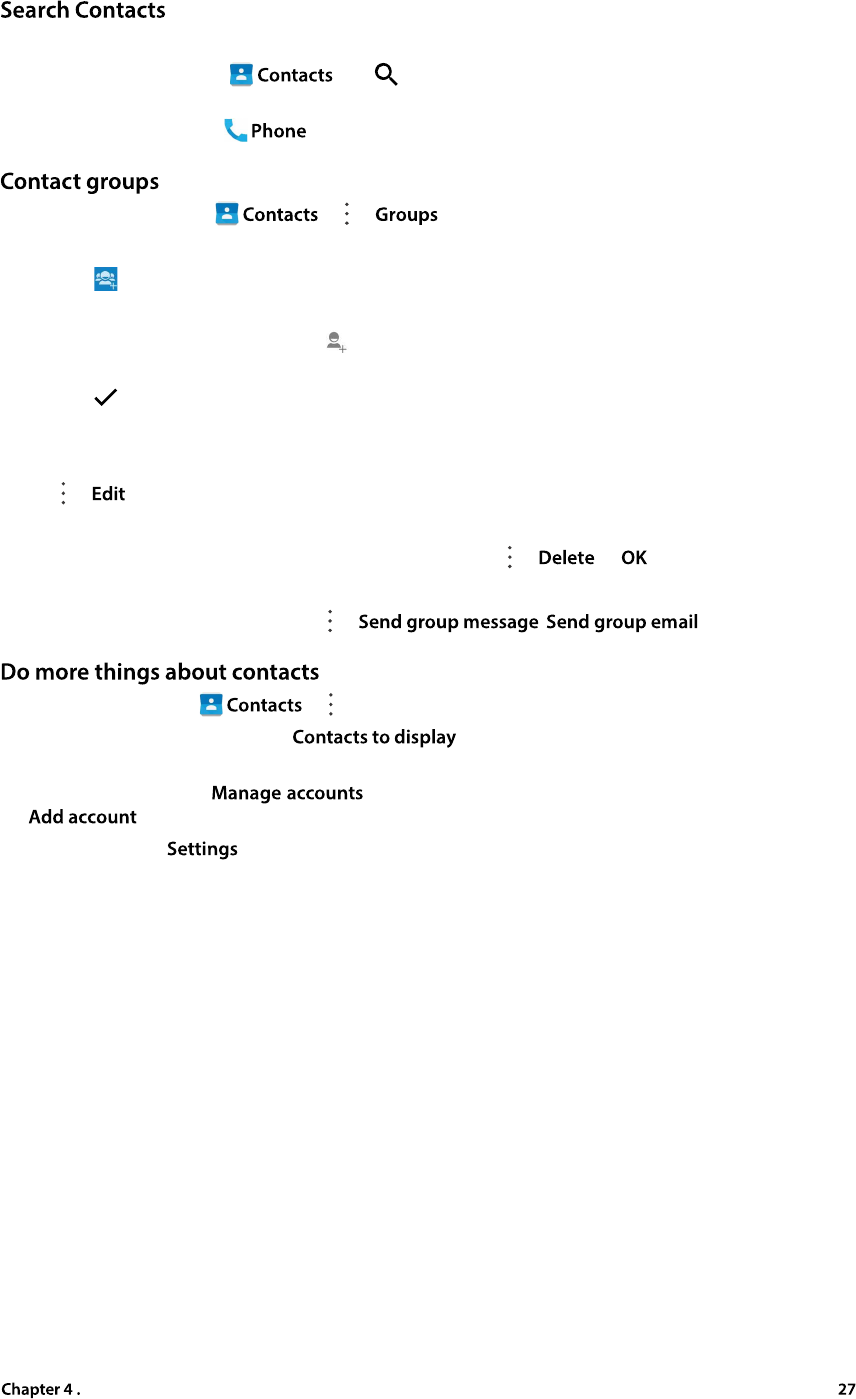
Calls and Contacts
On the contacts list, you can use the following search methods:
•
On the Home screen, tap
. Tap
and enter the name, initials, or number of a contact in the
dialer contact.
•
On the Home screen, tap
. Tap the search bar and enter the name, initials, or number of a contact.
On the Home screen, go to
->
->
to view the contact groups.
•
Create a group
1.
Tap
to create a group.
2.
Choose the account (SIM1/SIM2/Phone contact) you want.
3.
Enter the group’s name, and tap
(or enter the contact name) to select the contacts you want to
add to the group.
4.
Tap
to finish.
•
Edit a group
On the group list, tap a group to view the contacts belong to.
Tap
->
to edit the group.
•
Delete a group
On the group list, tap the group you want to remove and tap
->
->
.
•
Send a group message/email
On the group list, tap a group and tap
->
/
.
On the Home screen, tap
->
, you can:
•
Select the account to displa
y: Tap
and select the account (SIM1/SIM2/Phone contact)
you want to display, or customize the display options.
•
Manage accounts
: Tap
to view your accounts. If you want to add a new account, tap
and follow the onscreen instructions to add your account.
•
Set contacts
: Tap
to set the contacts order, including sorting rule, name format, default account
and contact information.
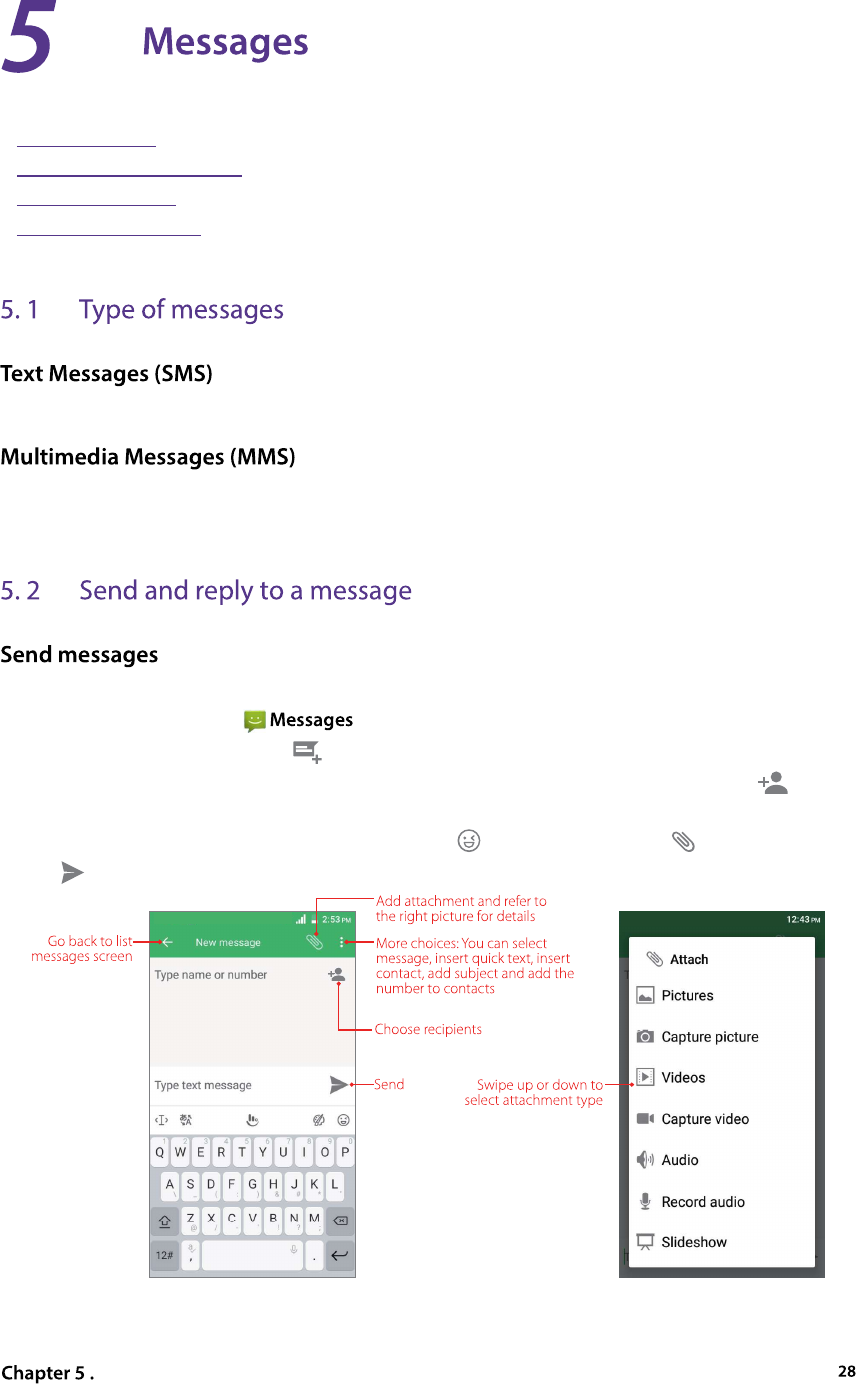
Messages
Use Messages to keep in touch with your friends.
• Type of messages
• Send and reply to a message
• Search for messages
• Manage your messages
The Short Messages Service (SMS) lets you send and receive text messages to and from other mobile phones.
The Multimedia Messaging Service (MMS) lets you send and receive multimedia messages (such as pictures,
videos, and audio messages) to and from other mobile phones.
Spice up your messages by adding emoticons, images, videos, music, recordings, and more.
1. On the Home screen, open .
2. In the list of message threads, tap .
3. Select the recipient box and enter the contact name or phone number. You can also touch to open
your contact list and choose a contact or contact group.
4. Select the text field and enter your message (You can tap to add emotions and tap to add attachments).
5. Tap .
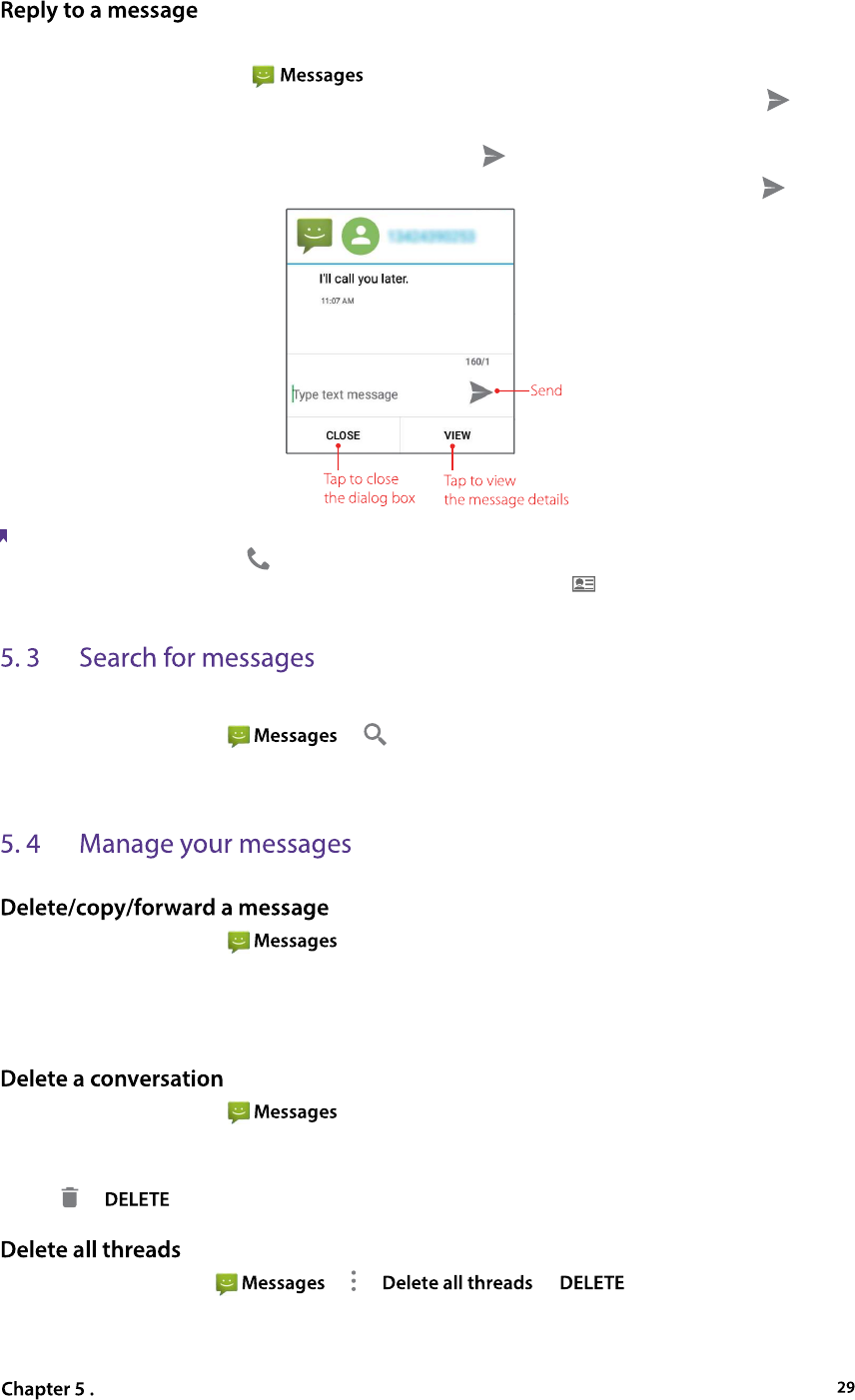
Messages
You can reply to a message by following ways:
• On the Home screen, open . In the list of message threads, tap a contact name or phone
number to view your conversations. Select the text field and enter your message, and then tap .
• Swipe down from the top of the screen to open the Notification Panel and tap the message notification,
Select the text field and enter your message, and then tap .
• New messages will be displayed in a popup screen. You can type your messages on it and tap .
Note:
1. You can reply a call by tapping .
2. You can add the phone mumber to contacts and edit the contact by tapping .
Use the message search feature to find messages quickly.
1. On the Home screen, tap -> .
2. Enter one or more keywords. The search results will be displayed underneath the search bar.
1. On the Home screen, tap .
2. In the list of message threads, tap a contact name or phone number to view your conversations.
3. Touch and hold the message, you can copy/forward/delete/lock the message, view the message details,
select the message text and save message to SIM card.
1. On the Home screen, tap .
2. In the list of message threads, touch and hold a coversation, and then select the conversations you want
to delete.
3. Tap -> .
On the Home screen, go to -> -> -> to delete all the threads.

Messages
One Cell Broadcast message can reach a large number of terminals at once. You can go to ->
-> to view the cell broadcast messages.
The messages stored on the phone or on the SIM card. You can go to -> -> to
view the messages on the SIM card.
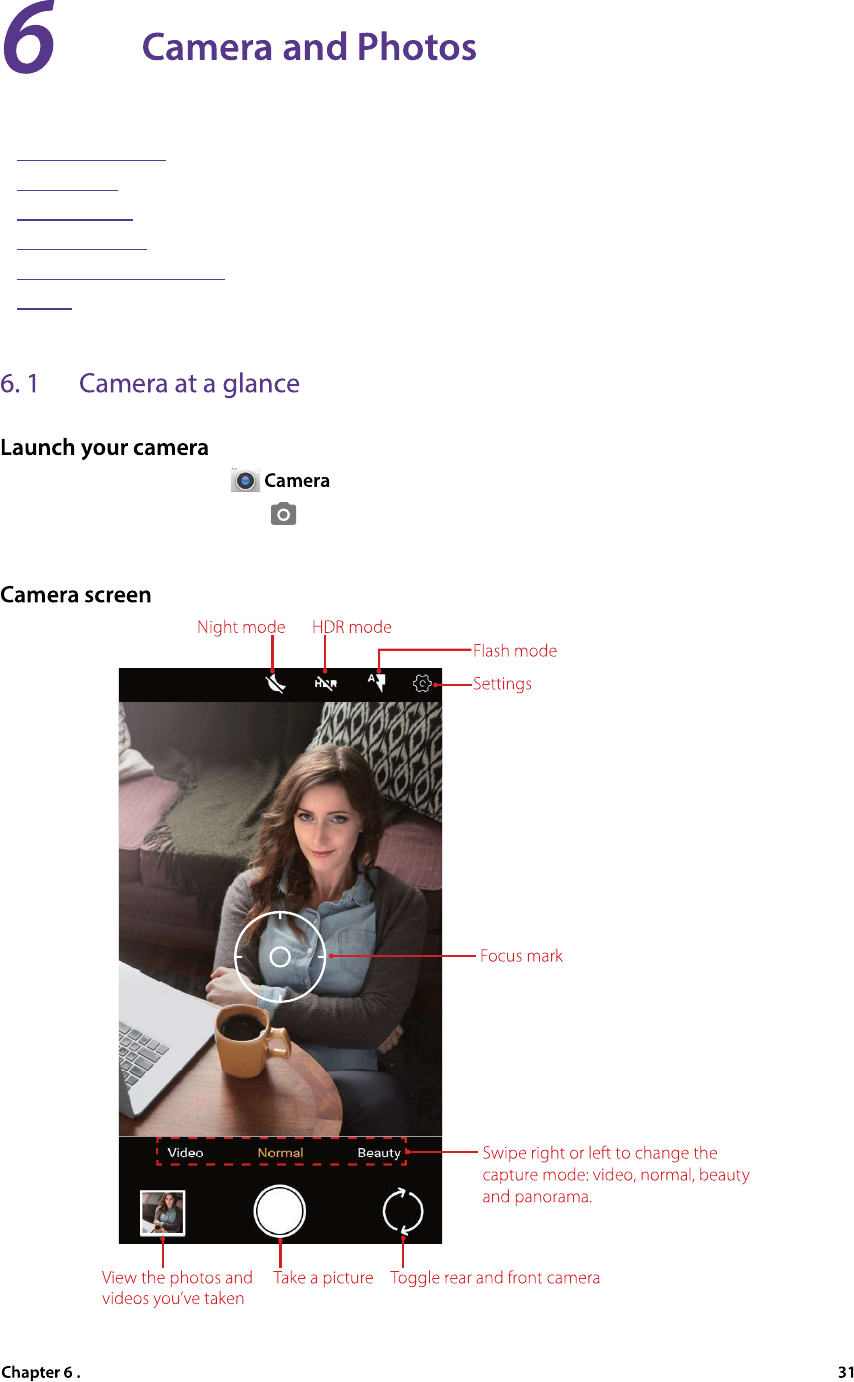
Camera and Photos
Use multiple features of your camera to capture your precious moments.
•
Camera at a glance
•
Take a photo
•
Record a video
•
Shooting modes
•
Camera and video settings
•
Photos
•
On the Home screen:
Tap
.
•
On the Lock screen:
Just swipe
up.
•
On the off screen:
Press the Volume-down button twice to snapshot.
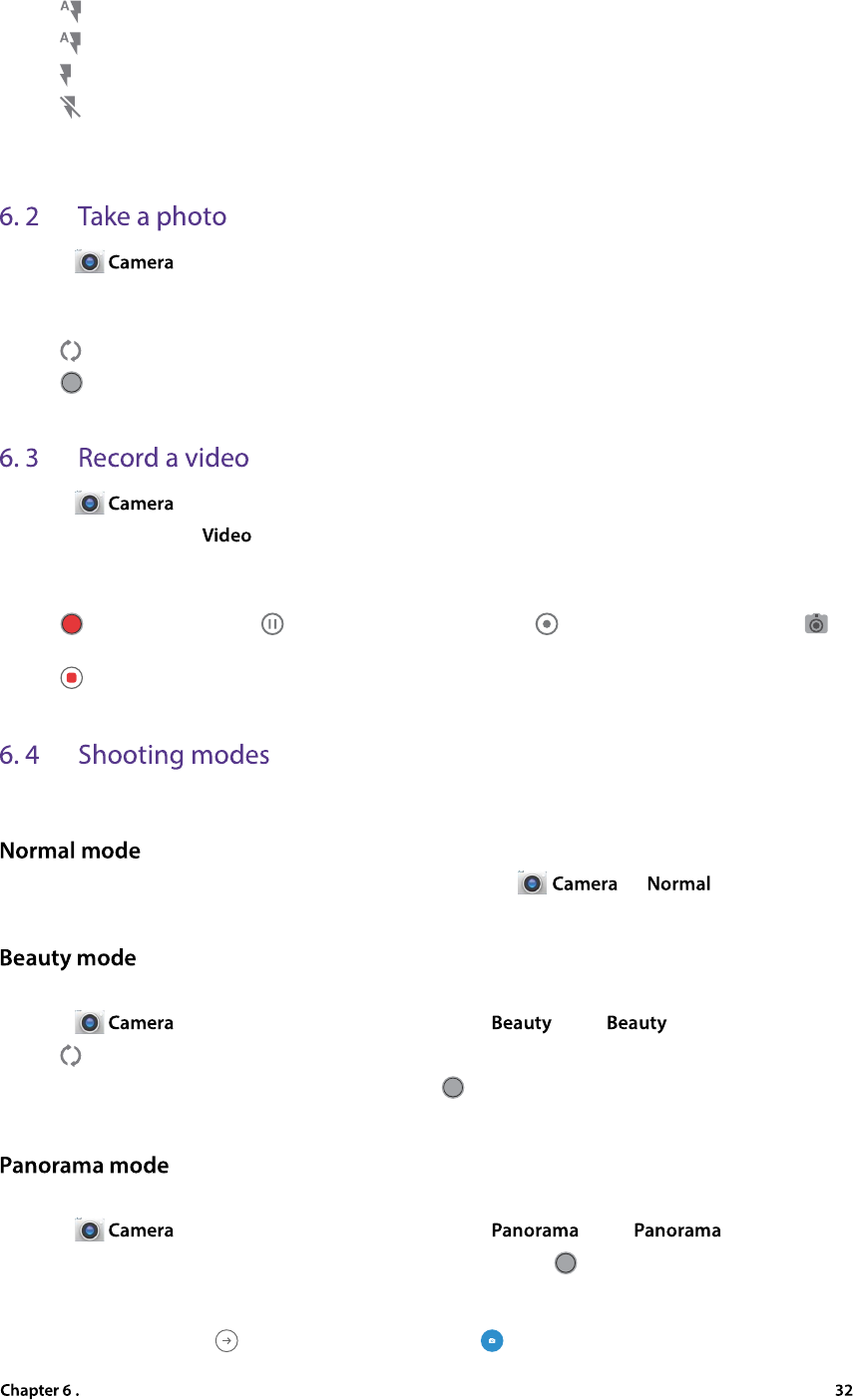
Camera and Photos
1.
Tap
to display flash modes’ three options:
•
Automatically enables or disables the flash based on the ambient brightness.
•
Enables the flash.
•
Disables the flash.
2.
Tap the viewfinder to manually focus. A beeping sound notifies a successful focus.
1.
Open
.
2.
Frame the scene you want to capture, touch any part of the viewfinder to focus on the corresponding area.
To adjust the focal length, pinch two fingers together or spread them apart on the viewfinder.
3.
Tap
to switch between the front camera and rear camera.
4.
Tap
or press the Volume button to take a photo.
1.
Open
.
2.
Swipe right to choose
mode.
3.
Frame the scene you want to capture, tap any part of the viewfinder to focus on the corresponding area. To
adjust the focal length, pinch two fingers together or spread them apart on the viewfinder.
4.
Tap
to record a video. Tap
to pause the recording and tap
to continue the recording. Tap
on
the screen during recording to save the current scene as a photo.
5.
Tap
to stop and save the recording.
Your phone features a variety of different camera modes for different shooting scenarios.
Your phone is set to use normal mode by default. You can go to
->
to enable normal
mode.
Use beauty mode for stunning selfies and smoother-looking skin.
1.
Open
, swipe the viewfinder left
and select the
or tap
directly.
2.
Tap
to switch between the front camera and rear camera.
3.
Frame the scene you want to capture, and then tap
or press the Volume button to take a photo. The
camera will automatically detect each face in the photo and apply the beauty settings.
Use this mode to take wide-angle shots.
1.
Open
, swipe the viewfinder left and select the
or tap
directly.
2.
Select a suitable location and hold your phone steady, and then tap
or press the Volume button to start
shooting.
3.
Follow the onscreen instructions to take the photo. Slowly move your camera horizontally or vertically,
ensuring that the arrow
stays level with the center line
.
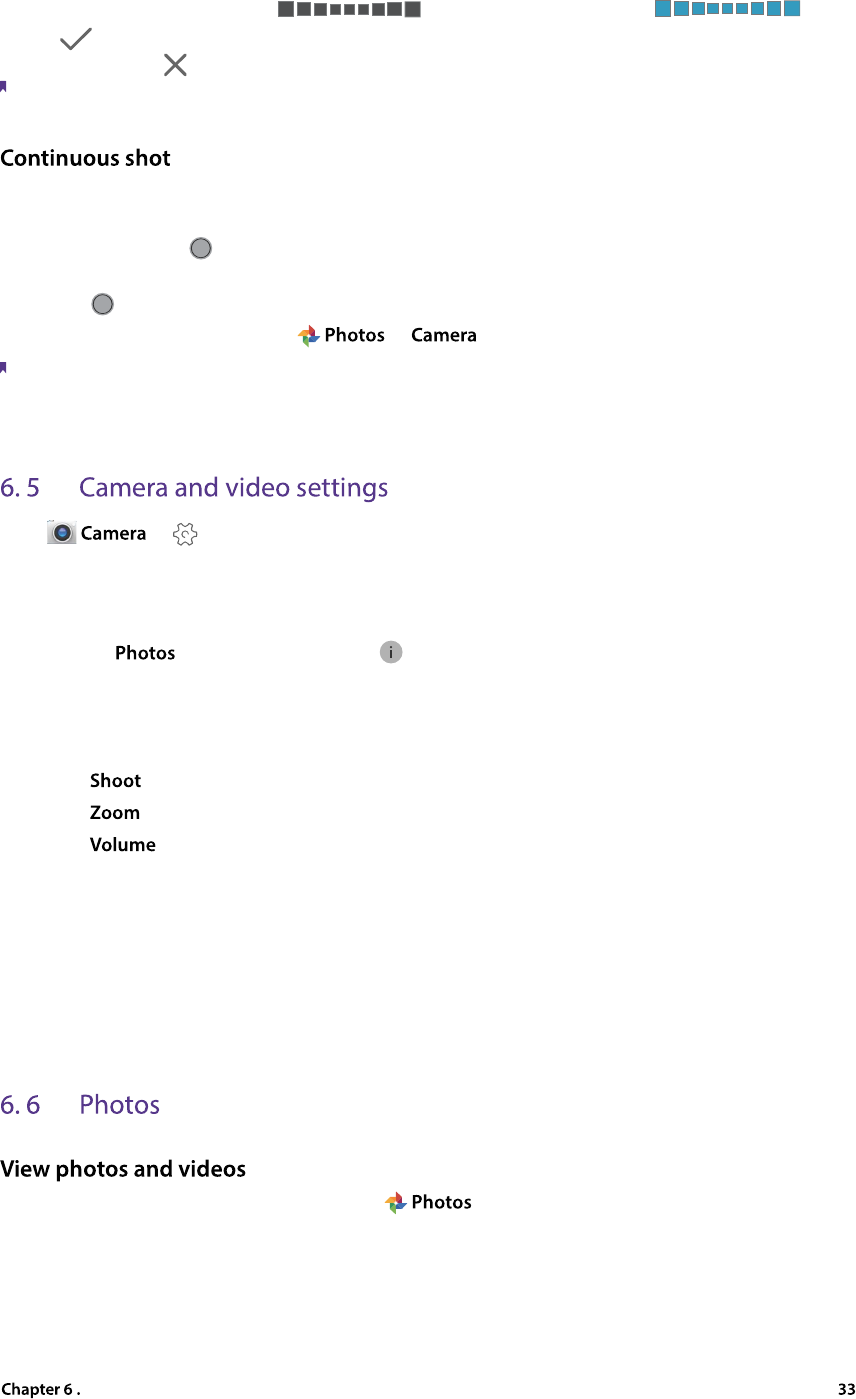
Camera and Photos
4.
With the capturing, the squares
will gradually change to blue
.
5.
Tap
to save the capture. The camera automatically stitches the photos together to create one panoramic
photograph. Tap
to cancel the capture.
Note:
Excessive deviation and moving too fast will lead to fail in capture.
Use continuous shot when you want to take a photo of a moving subject, such as during a football match. The
camera will capture several images in quick succession.
1.
Touch and hold the
or press and hold the Volume button to start the burst sequence. The number of
captured photos will be displayed in the bottom of the viewfinder.
2.
Release
or Volume button to stop the burst shooting.
3.
Tap the image thumbnail or go to
->
to view the photos.
Note:
1.
This feature is not available in Panorama mode, Face beauty mode.
2.
You can take up to 40 photos in one burst sequence, provided that there is enough storage space on your phone.
Go to
->
to configure the following camera settings.
•
GPS location info:
Save the location where the photo was taken (only when your phone is connected to the
Internet and enabled location access).
1 )
Tap to switch on and then take a photo.
2 )
Go to
, select the photo and tap
to view the location information.
•
Picture size:
Set p
icture size
, such as 5M(16:9)/5M(4:3)/4M(16:9)/3M(4:3)/2M(16:9).
•
Touch capture:
Tap to enable capture by touching the screen.
•
Volume key:
•
Tap
, you can use the Volume button to shoot.
•
Tap
, you can use the Volume button to adjust the focal length.
•
Tap
, you can just use the Volume button to adjust the volume.
•
Shutter sound:
When Shutter sound is on, a shutter sound is played during taking a picture or recording a
video.
•
ZSD
:
Turn on this switch, and you can take photos with faster snapshots.
•
Self timer:
Set Self timer, such as Off/2 seconds/10 seconds.
•
Video quality:
Set Video quality as Low, Medium, High or Fine.
•
Restore defaults:
Tap to restore camera settings.
You can view the following photos and videos in
:
•
Photos and videos shot with the camera.
•
Photos and videos that your friends shared with you.
•
Photos and videos synced from your computer.
•
Photos and videos saved from messages, emails, or websites, as well as screenshots.

Camera and Photos
Go to :
• Select a photo, you can manage your photo with the following options: play in slideshow, move to folder,
copy to folder use as contact photo or wallpaper, print the photo and delete from device.
• Select a video, you can manage your video with the following options: play in slideshow, play the video on
loop, move to folder, copy to folder and delete from device.
• Go to trash, you can restore the photos (videos) or permanently delete the photos (videos)
You can use the image editing tools to bring your photos to life.
Select an image you want to edit and tap , you can add a filter to the image, adjust the image parameters,
crop the image, straighten the image and rotate the image.
You can use the photos‘ video editing tools to edit a video.
Select a video you want to edit and tap , you can stabilize the video, rotate the video and clip the video.